I was at the downtown W. Dale Clark Library many months ago when I first came upon her name. I was deep in research, working a case, looking to put the finger on some gin mill or grifter long before my time. Gunnin’ for a piece of evidence from one case or another. I can’t be sure now….but I’m trying to sound really tough in my Burberry trench on this rainy day. Adelaide Fogg. The 1927 newspaper read “New Home for Miss Adelaide Fogg” in big, bold print, as if it was assumed I knew her name. I tried to stay the course, betwixt my current mystery and this new colorful distraction. It did not help matters that this New Home featured below the headline was an architect’s drawing of one of my favorite Dundee darlings—a home I, quite literally, drive by every few days.

New Home for Miss Adelaide Fogg. The exact article I found on that day.
I was led, you see. I immediately conjured her name, her whole story, really. A sort of visual experience. Also Adelaide Fogg sounded divine. (Honestly, these fancies are part and parcel where I often drift when a person might call to me and I don’t answer.) Adelaide Fogg. Like a true 1920s storybook character, I could imagine her: A mixture of the mysterious, perhaps with an unexpected, unusual sense of humor, meanwhile, just maybe, a physicality and a matching expression commanding reverence. A little odd. It was as if her parents knew, with a name like that…. a kind of preemptive wink to the stars. At any rate, I was bewitched.
Months later I would return to my initial scribblings on her, as not to forget, as if I could, and began an Adelaide Dossier of her very own. The tale of Miss Fogg was not revealed to me, like any of these mysteries, in a chronological order, compounded by the fact that I had never gone off on a detective’s beat, based on only a name (but a good name) and an architect’s rendering of a house (although a very good house). Who knew where this would lead? But we all realize when we come here that I don’t have the ticket. Miss Cassette is an amateur Nancy Drew at best. The glimpses and revelations came at me all willy-nilly as the weeks went by. But I can tell you, Omaha friends, that my search for Adelaide Fogg was quite thrilling as I turned up each clue. Her story, surprisingly, was one of an unorthodox woman with twists, turns, pirouettes, Who’s Who connections and untold heartbreak.
Young Adelaide
In my attempts to gather the puzzle pieces, the search for Miss Fogg appeared to begin in 1897. The year of her birth. Her father, an Omaha pharmacist, was from the East Coast originally, and upheld his East Coast sense of decorum and adherence to social form. Both Adelaide’s early attraction to dance and her father’s response to her passion, which will be covered later in this case, would shape this free spirit’s whole life. By the age of five Adelaide was struck with spinal meningitis and spent the next two years in bed. Two years. Can you imagine? A specialist at that time recommended dancing lessons to strengthen her leg muscles. This unfortunate event, turned blessing, when Adelaide began studying at the Chambers Dance Academy, an elite West Farnam dancing school that would come up again and again in the research of this story. For more on the West Farnam Neighborhood, check out Brothers Lounge and the Case of the Vanishing Mom and Pop.
My first pointer of Miss Adelaide Fogg was from the Omaha World Herald, dated May 14, 1911. “Around the World with Terpsichore,” the headline read. This was a large affair described in full detail, outlining a Saturday afternoon and evening performance for the benefit of the Child Saving Institute. Little did I know Adelaide would continue her affiliation with the Child Saving Institute throughout her life. From the very beginning, Adelaide was dancing with the Silver Spoon Offspring of Omaha. (That is not a dance troupe.) Here is but a small sampling of the last names mentioned in this article: Nash, Woodard, Cudahy, Smythe, Offutt, Langdon, Wallace Hitchcock, Barton, Metz, Crofoot, and Fuller were all listed for their various dance numbers. For those of you not attuned to the Society Pages of early Omaha, those are some of the Heavy Hitters of the Closed Set.

Child Saving Institute. Previously located at 619 South 42nd Street. This is the east side of the street, right in the middle of the current UNMC campus. (Photo courtesy of the Bostwick-Frohardt/KM3TV Photography Collection at The Durham Museum Photo Archive). May 11, 1925. For a look at what Child Saving Institute is up to now, check out http://www.childsaving.org/home.

May 25, 1911 “Prize Ticket Sellers.” Little Miss Fogg sold $60 worth of tickets for the event, winning a prize and her very first appearance in the Omaha World Herald. I mistakenly thought this might be a bit of detective’s luck, as if I have anything to do with what falls in my lap. This small article was actually a very early indication of Adelaide’s character—a fierce sense of competition, rare power, charm and true, natural talents in a number of areas. And we might never have known her name had her capacity for greatness not been united, of course, with a generous amount of family resources and social connection. Familial kismet, we’ll call it. Whatever it was, the stars came together for Miss Adelaide Fogg. As Mr. Cassette always says, some people just vibrate on a higher level. But Adelaide Fogg was not always to have it so easy and mind you, she had already overcome spinal meningitis.
Years before the start of World War I, Adelaide along with her sister, Ione, entered into an audition at the Chambers Dance Studio. The call was for young dancers as part of the Ak-Sar-Ben Coronation Ball choreography that year. There was stiff competition but Adelaide and her boy partner, John O. Yeiser were winners, along with sister, Ione who was paired with Wayne Selby. The two couples infamously beat out Fred Austerlitz and his sister, Adele, son and daughter of a Storz brewing official. This runner-up couple eventually became better known as Fred and Adele Astaire.
I was quite surprised when the evidence tipped me off in another direction. By May 22, 1914 the headline read “Misses Fogg and Smith Battle for the Cup. Tennis Finals are Being Played this Afternoon at Brownell Hall.” I was muddled for a few minutes as I digested the goldmine of articles of photos about Miss Adelaide Fogg, the tennis champion of Brownell Hall. How was I already finding so much press under this girl’s name and what would she become as an adult? Miss Adelaide Fogg, tennis champion of Brownell Hall for the last two years to compete with Miss Margaret Smith in the finals. “It is predicted that the contest today will be bitterly fought out.” Later in the article it sweetly mentioned Brownell Hall Field Day on Saturday with various contests and “an appropriate May-pole dance.” I should say.

Brownell Hall or sometimes called Brownell Academy was then an exclusive school for young women.
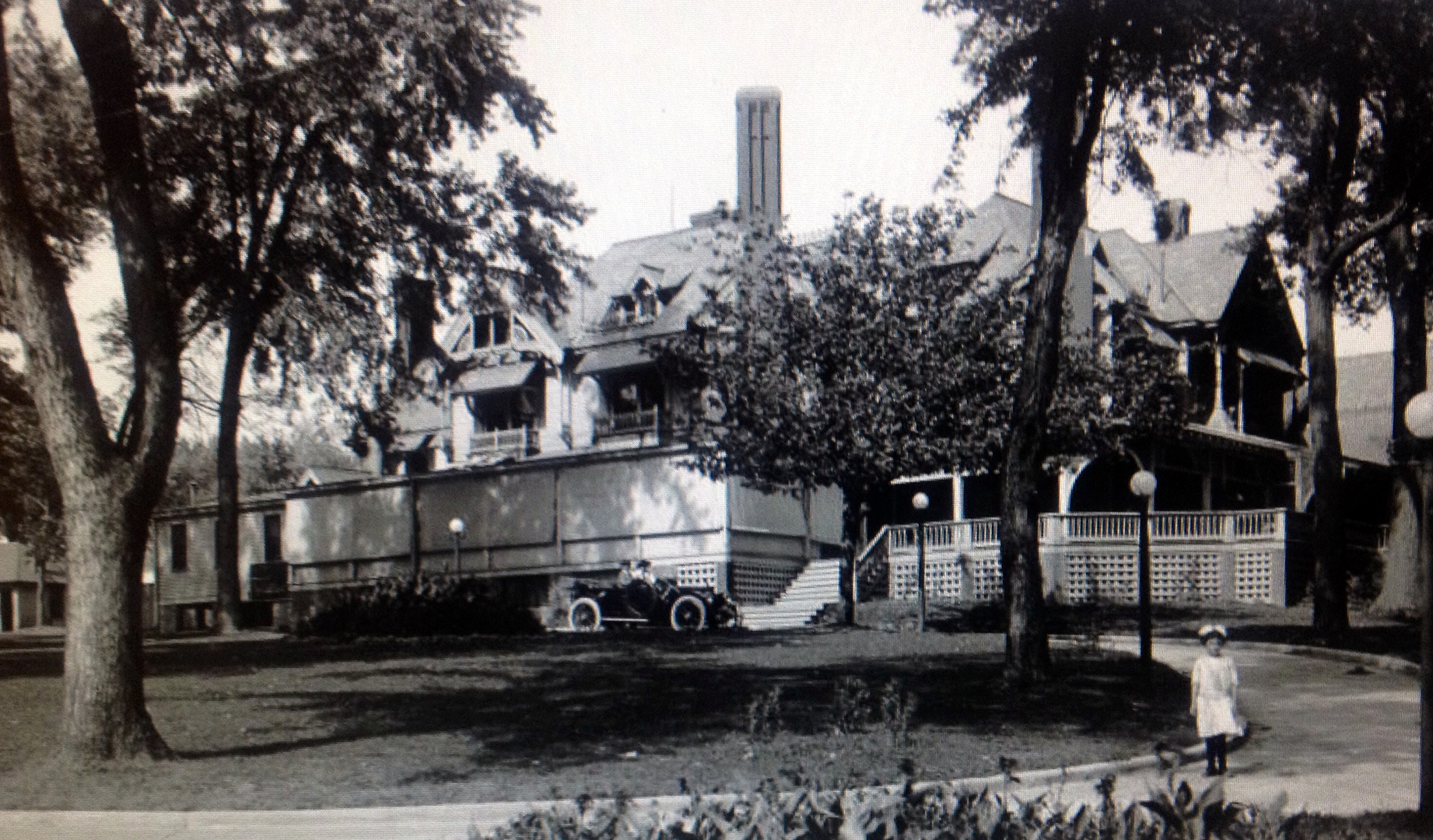
1910. Brownell Hall at 400 North Happy Hollow Blvd. This was the old Patrick family mansion originally. More on that at The Curious Case of the French Fairytale Cottage: Part One. I come across mention of Brownell Hall frequently in researching these articles, as this was The School for Well-Heeled Girls. And guess what? They have the same exact address, although the building has changed and it is now co-ed. https://www.brownell.edu/
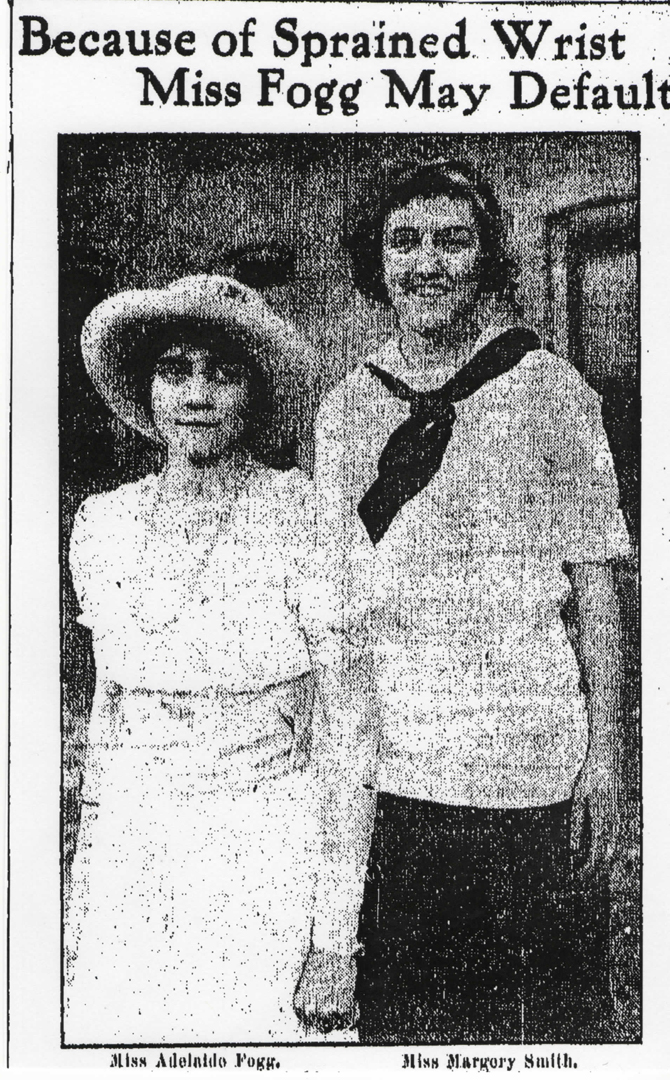
This is my favorite photo of Adelaide. May 26, 1914. Days later the paper warned of Adelaide’s potential for default due to a sprained wrist from pitching ball. Pitching ball? She probably did that well too. Her she is seen with her opponent, Margery Smith.
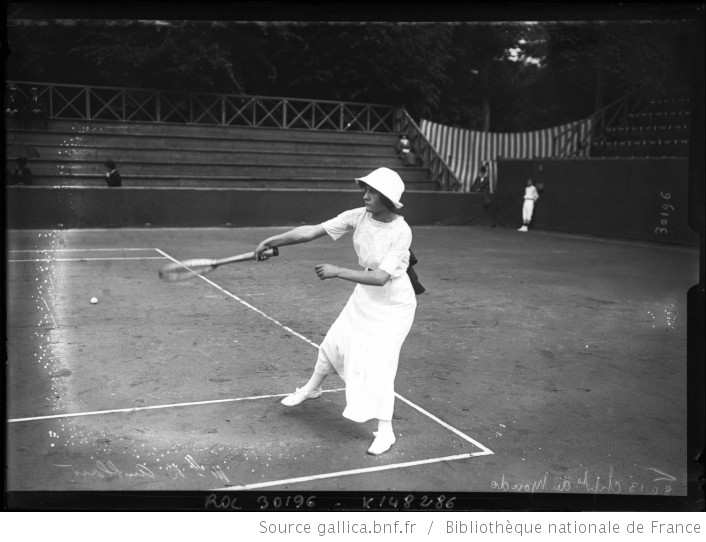
Female tennis was really taking off at this time and becoming more popular . The outfits are really pretty remarkable. Here is a very nice one of Blanche Amblard at the World Hard Court Championships, St Cloud, June 8th 1913, which gives a real feel for the time period that Adelaide was competing. To see more wonderful white tennis outfits, check out http://www.tennisforum.com/59-blast-past/894746-history-womens-tennis-pictures-3.html
By November 24, 1914 Adelaide was in the paper again. “Miss Fogg Won’t Be In a 1914 Institute Play.” What? “In addition to her expertness as a tennis player, Miss Fogg has assumed a leading part in the three previous annual plays presented for the benefit of the Child Saving Institute, will be unable to participate in this year’s presentation. Taken quite seriously ill with appendicitis several weeks ago and underwent an operation. Recovering at 3116 Dodge street home. Expected to resume her studies at Brownell Hall next week.” This was the first article that led me to assume that I was chasing down the lead of budding superstar. I was also given the clue of Adelaide’s home address.
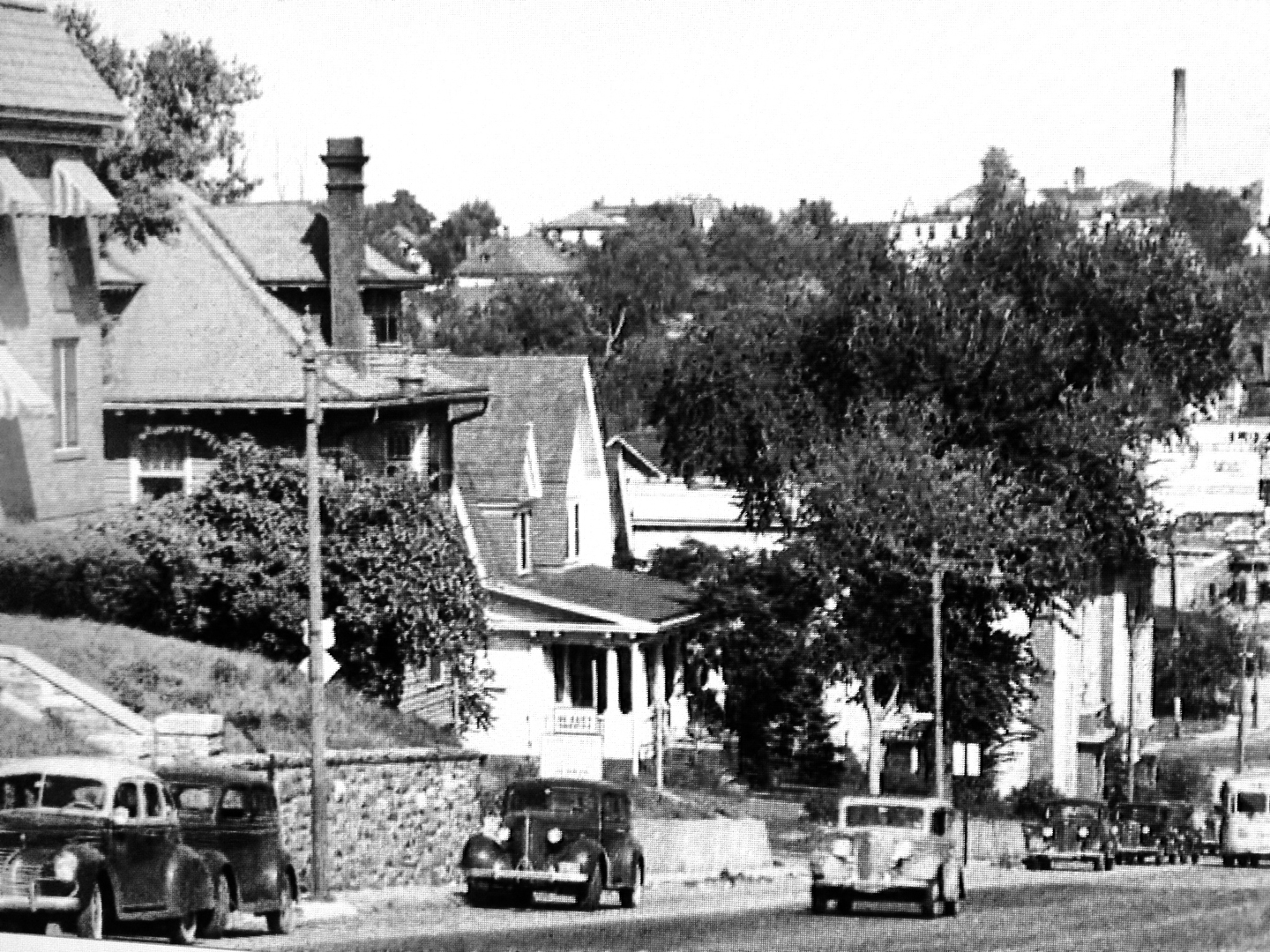
3116 Dodge was most likely one of these homes shown along Dodge. Looking east on Dodge Street from about 32nd Ave. There is car and bus traffic in the street and cars are parked at the curbs. At the left are two brick apartment houses and some houses further down Dodge. Turner Park was already situated on the south side of the street. And now we know what that ghost of a stone fence was from! Still across from, as Mr. Cassette has aptly named it, Midtown Crisis AKA Midtown Crossing. (Photo courtesy of the Bostwick-Frohardt/KM3TV Photography Collection at The Durham Museum Photo Archive) August 8,1940.
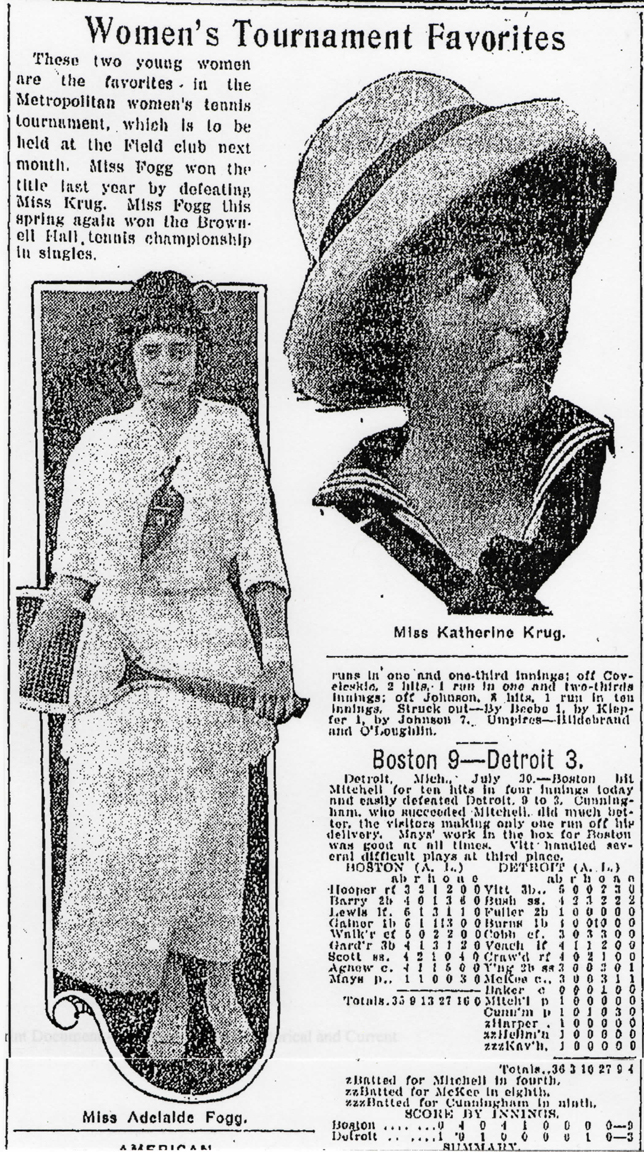
July 31, 1916 Article Women’s Tournament Favorites article. Katherine Krug of the Krug Park and Brewing empire.
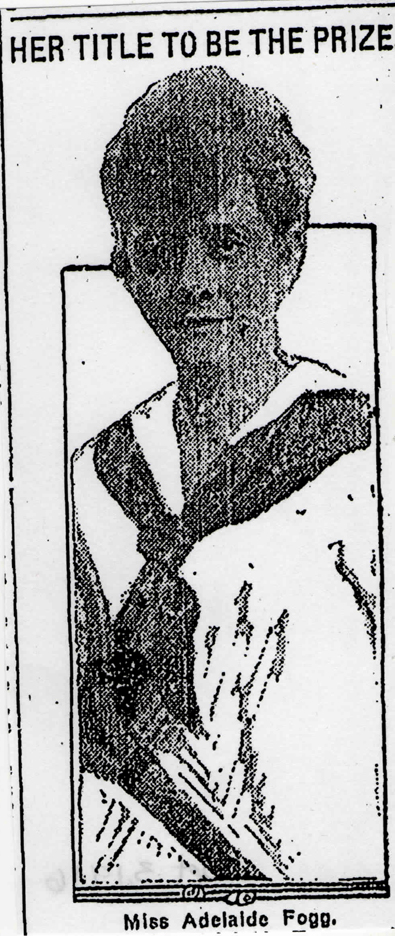
Sept 3, 1916 Her Title to be the Prize. I loved this short article on Adelaide. “For a little mite like herself Miss Fogg plays a brilliant net game. She is nerve all through and her forte is returning everything that comes across the net to her. She is left handed, and this as a measure is an asset. Left handed players, as a rule, have something that right-handed players cannot solve.” The phrasing is divine.
For the Love of Dance
Accompanied by her mother, Adelaide set off for New York City in 1917. She began studying under ballet master, Stefano Mascagno. According to Adelaide, later in life, this was a compromised agreement whereby her father agreed to pay for her extensive ballet training in return for her promise to only dance in the classroom.
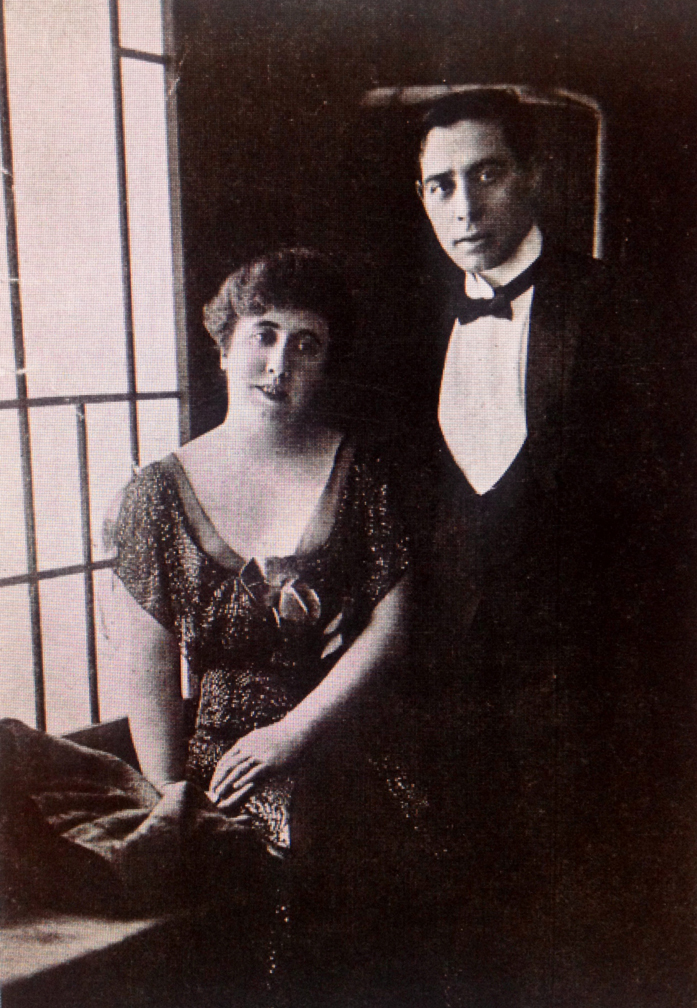
Josephine and Stefano Mascagno. Mascagno considered Adelaide a pupil of great promise. Later he began using her as a demonstration teacher, featuring her in films and national trainings. Adelaide would go on to be offered jobs with the Metropolitan Opera Company and another chance, traveling with the national Orpheum circuit. There was countless opportunity awaiting Adelaide, which she dutifully declined to honor her father.
The whole while she was gone, the newspaper kept Omaha up to speed on Adelaide Fogg. From September 17, 1918, “Miss Adelaide Fogg returned Saturday from NY, where she has spent the last six months studying dancing with Mascagno and Duryea. She also attended the Dancing Masters’ convention at the Astor Hotel. Miss Fogg will give a reception on the afternoon of Saturday October 5 at the Blackstone, where she will give a program. She is to have her classes at the Blackstone Hotel during the winter.” This was the first mention of Fogg starting her first dancing classes at the Blackstone Hotel Ballroom. She spent three months of each of the next ten years continuing her studies under Mascagno, returning always to Omaha, as a dance instructor.

The Blackstone Hotel Apartments of this time period. 1916. 302 South 36th Street.
From the Shapes of American Ballet: Teachers and Training before Balanchine by Jessica Zeller, I learned Stefano Mascagno 1877-1950, an Italian, began his training at age 10,under his father who was famed dancer and choreographer in Naples. Stefano was dancing thee to four hours a day as a child. He made his debut at San Carlo at the age of 17. Considered a success, he was hired at the Regio Teatro in Turin. Later he joined the ballet in Moscow. His career took him to Berlin and United States, Central and South America. Became the principal ballet master of ANAMD’s Normal School between 1918 and 1925, a source of much of his acclaim as a teacher across the United States. He would go on to found the Mascagno School of Dancing with wife, Josephine Mascagno, featured in the previous photo.
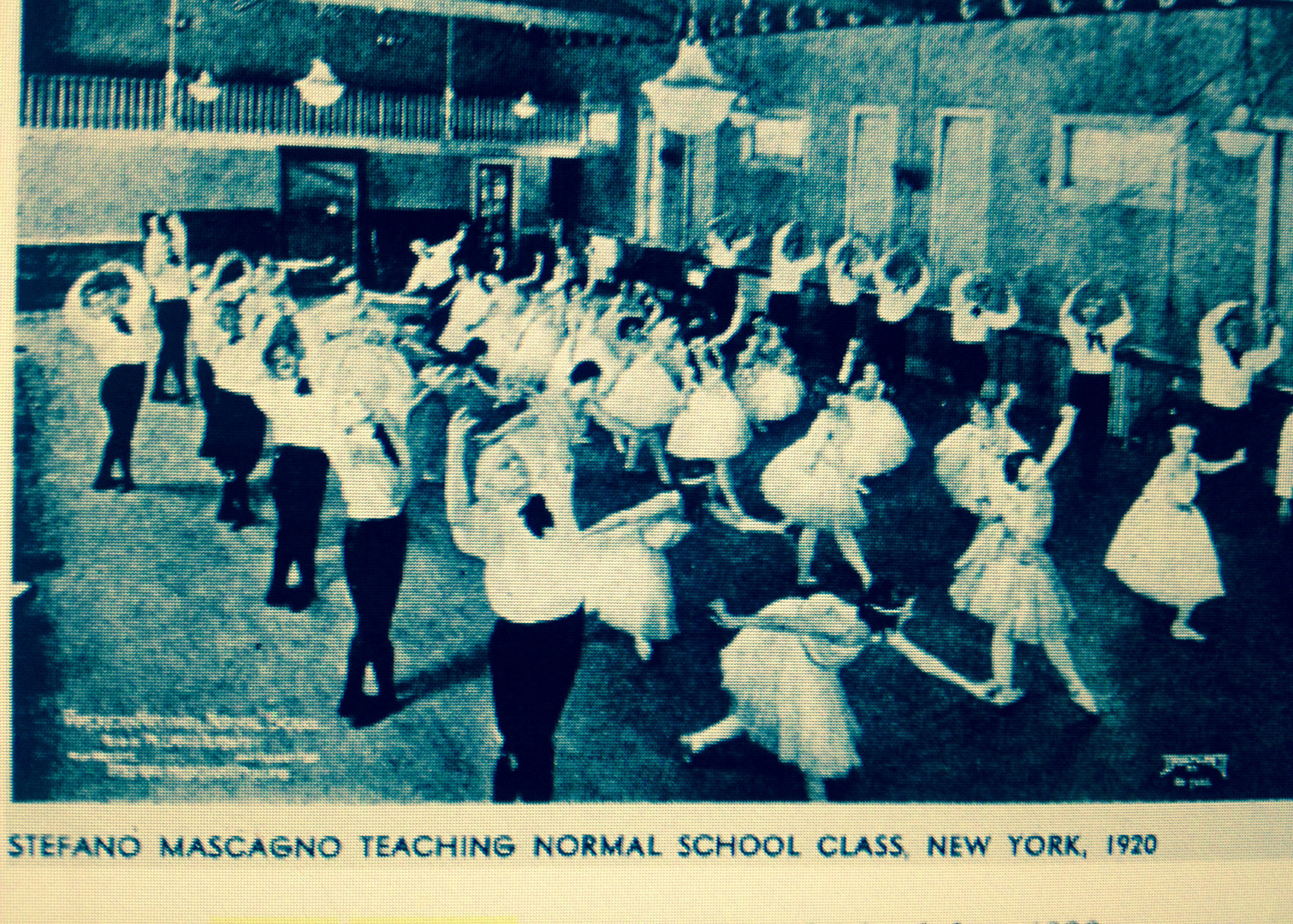
1920 Stefano Mascagno teaching his students. It is highly possible that Adelaide is in this photo. By October 5, 1918 Adelaide was frequently in the Omaha World Herald as a “dancing teacher” and making mention of the “beautifully trained dancers of Miss Adelaide Fogg.”
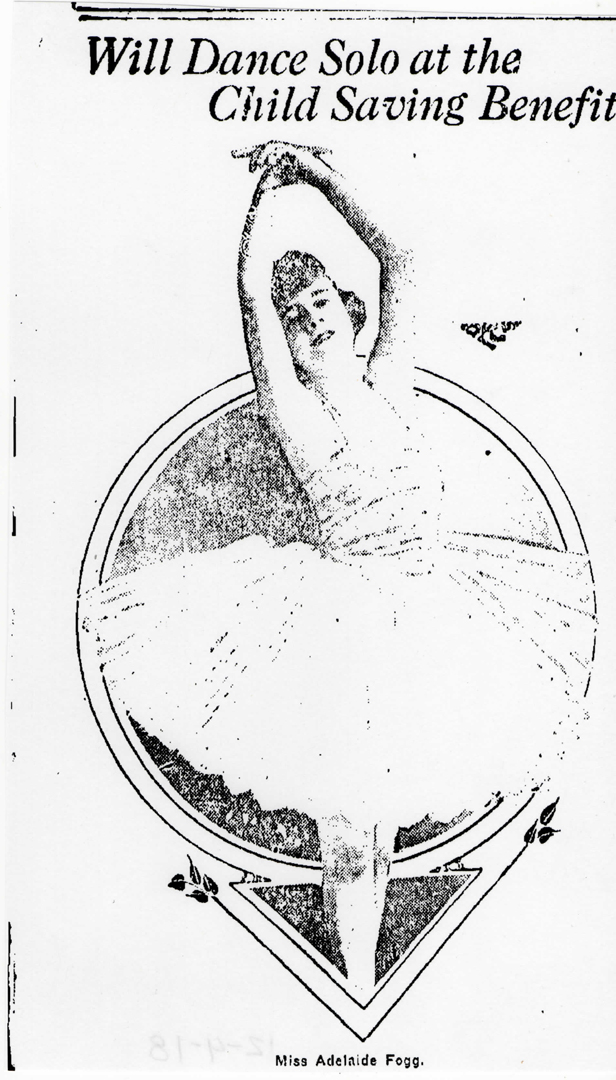
December 4, 1918: Will Dance Solo at the Child Saving Benefit. “A solo dancing number entitled ‘Over the Top’ will be danced by Miss Adelaide Fogg of Omaha, at a benefit given in the auditorium for the Child Saving Institute.” She had recently “specialized in toe dancing in NY under Stefano Mascagno and will wear a ballet costume in this number the bodice being of blue and the skirt of white with red streamers.” From her very early dancing days, Adelaide’s father would take issue with her costumes, insisting that they were modest and proper.

April 6, 1919: Adelaide Fogg to Take Leading Role in Play for Fatherless War Orphans. Adelaide would play Louise, the blind girl in an old French drama “Two Orphans” for the benefit of the fatherless children of France. This was a common fundraiser during this time due to the first World War. “Miss Fogg is well known as a dancer but Mrs. Isabelle McLaughlin, coach for the play, says that the young woman also has remarkable dramatic ability. Two Orphans will be performed at the Brandeis Theater when Mrs. Barton Millard, president of the Society for the Father Children of France and other officers will sponsor the benefit.” Yet another hidden talent of Miss Adelaide Fogg!
Adelaide’s father, Frank W. Fogg, was by this time a well-known pharmacist. His drug store was down on 2802 Farnam in the Park East neighborhood of downtown Omaha. For more on this area check out The Secret of the Muse Theater. 2802 Farnam had previously been the James Horn Saloon in 1916. This address no longer exists. It is around the area of American Plastics Supply and Fabrication, by the 480-entrance ramp.
Troubled Times
A piece of evidence led me to a disturbing article from November 25, 1919, entitled “Flowers Arrive for Victim of Murderer.”
“Flowers began to arrive to today at Gentlemen’s Mortuary for an unidentified girl, whose body was found last Thursday morning in a ravine twelve miles north of Omaha. Among those who sent flowers to the morgue were Adelaide Fogg and the Kimball Laundry.” As the hours passed, apparently, hundreds of people visited the morgue in hopes of furnishing a positive identity for the dead girl. This is interesting to me because that signifies that there were either a lot of missing girls that people were wanting to identify or people wanted to get a peak at something gruesome. Those were different times. If the murdered girl was not identified by the next day, the article alerted, “a simple funeral service would be held and she would be laid away in a receiving vault in Prospect Hill cemetery.”
Early of June of 1921 the newspaper ran a brief announcement that “Miss Fogg went away for the summer to New York.”
A few short months later I found this horrific news.
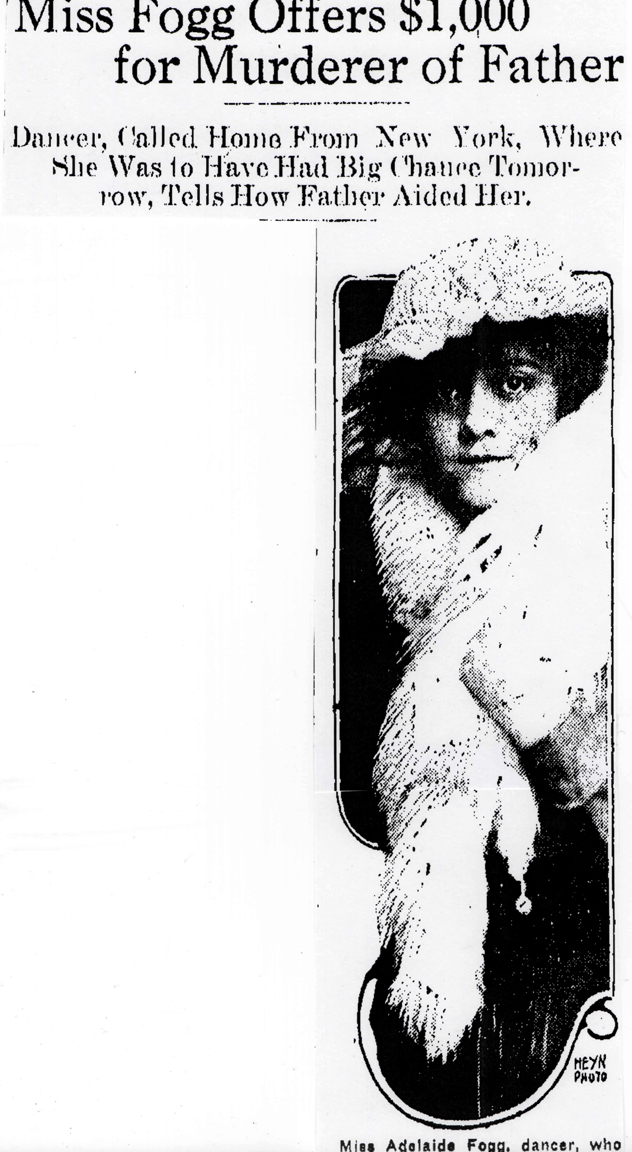
August 2, 1921 “Miss Fogg Offers $1,000 for Murderer of Father—Dancer Called Home from New York, Where She Was to Have Had Big Chance Tomorrow, Tells How Father Aided Her”
While Adelaide and her mother were back east, her father, Frank W. Fogg, was found slain in his store Saturday night. Miss Fogg immediately went to the Central Station once back in Omaha to confer with Chief of Detectives Vans Deusen concerning the hunt for her father’s assassin. The police were holding an African American man, named Virgil Price, in connection with the shooting. Adelaide insisted on seeing the man and did not believe that he could be the shooter. I could not understand from the article if he was being held because he was an African American but we can guess that this might have been the case. “Miss Fogg said she felt that perhaps Price was innocent and that he was being persecuted.” Adelaide fought for his release and Virgil Price was let go later that day. The detective declared, “I am hunting for a white man. I have a number of witnesses who will be able to identify him, as the man who entered the store not five minutes before Mr. Fogg was killed. Whether he is a drug addict or simply a holdup man, I can’t say.” This statement is incongruent with his previous determination that Price was guilty but it was hinted he was being held on other mysterious charges until Adelaide made plain her disbelief.
In a heartbreaking, telling statement, Adelaide was quoted as saying, “Father was so proud of everything I did. I lived and worked for him alone. And tomorrow was to be what I thought was my biggest night.” She was there to teach at the convention of Dancing Masters. And an affair at the Astor Hotel was to be the “biggest thing I had ever done. I had two dances. Miss Fogg thought her father was planning to come to New York and surprise her. The funeral was to be held at the 3116 Dodge home.”
But the story got worse still.
By August 9, 1921 the Omaha World Herald divulged a terrible secret. The headline read “Daughter Forgotten in Frank Fogg Will—Murdered Druggist Disinherits Daughter Married Against His Will–.Estate Worth $35,000.” In a shocking turn of events, Mrs. Ione M. Pangle, Adelaide’s sister, had been cut out of her father’s will. When Mrs. Mary Fogg (the girls’ mother) filed for probate in the county court, it was revealed her husband had left half interest in his estate to Mrs. Fogg and half to Adelaide. The will, found in his safety deposit box, did not mention his daughter, Ione. “Ione was estranged from her father in 1918 when she married George W. Pangle against her father’s wishes.” Apparently when Adelaide and her mother were on the east coast, Ione eloped with George, her husband. Father Fogg changed his will immediately following her elopement. They had not spoken since. It would appear that there were even deeper family issues because Ione was quoted as saying, “If Mrs. Fogg and my sister treat me nicely, I won’t contest the will. But if they are hateful I probably will bring action to break the will.” Exhibiting further bad form, Ione released to the press “My husband is well to do”, a stepson of the Hospe family of Council Bluffs and said his estate alone is valued at $50,000. “I don’t believe I shall want for anything all my life.” Another disclosure of the article was that Mr. Fogg forbade the marriage because George W. Pangle was older than Ione. Oddly, the article clarified Pangle was but five months older. Additionally the paper unveiled that Adelaide and Ione were stepdaughters to Mrs. Fogg. Their biological mother had died when they were one and three years old. Gasp.
Yet more disturbing news was to come.
Come October of 1921, James Saxton and W. O. Ryan were in court having to answer for their involvement in the Fogg murder. The two fellows were on foot the night of the murder, working the South Twenty-Eighth Street beat, in search of morphine. Mysteriously the two morphine addicts apparently heard the Fogg shooting and Saxton went to the drug store’s back door in an alley to check things out. He peered in through the back door to see “Mr. Fogg’s feet” on the ground behind the counter “but nothing else.” The prosecution wanted to blame Saxton for the killing. Two African American men, Mathew Hurtt and Albert Douglas came forward with key eyewitness accounts. The two had seen a “white man in a suit of green bronze with a gloss” running from the drug store alley on the night of the murder. The prosecution held that Saxton was wearing a dark green suit that night, although later proven to “contain no bronze” and “not having a gloss.” Years later the Fogg murder was described as a drug related stick up. I am not sure if it was ever solved. Adelaide and her mother would continue to live at 3116 Dodge Street.
**UPDATE** 10/12/16 Such a coincidental Omaha moment, I just had. I was just going through some old photos on my phone and ran into one I took about seven months ago of an old news article. I snapped the photo because of the incredible wiseguy language and complex, run-on sentences, which I later shared with a friend on Facebook. Once again, I read through the partial article and what do you know? It is all about Mr. Fogg and his suspected, Joe Pierce. What are the chances of that? I could not believe it.
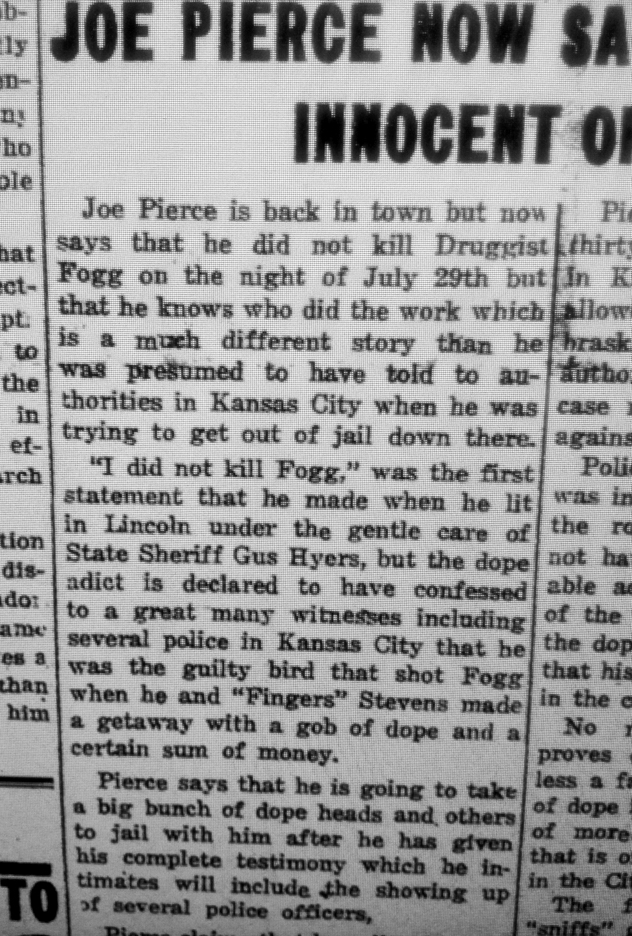
That first sentence is amazing. “He was the guilty bird that shot Fogg when he and ‘Fingers’ Stevens made a getaway with a gob of dope and a certain sum of money.” So Hammett.
The Renewed Love of Dance
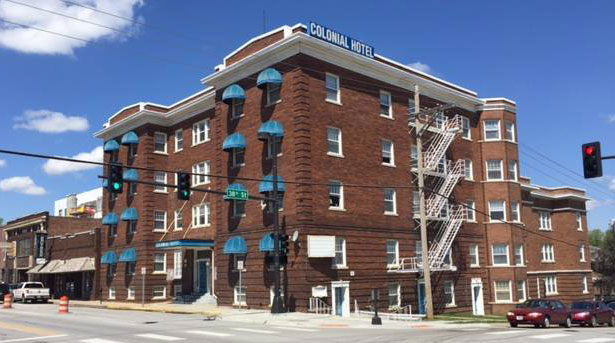
Colonial Hotel at 3804 Farnam Street.
Can you imagine those sad years? I am sure dancing must have saved Miss Adelaide. The papers were filled with Adelaide’s frequent trips to Chicago and New York for dancing workshops. I was beginning to wonder if she would get her big chance again, as she had mentioned when her father was killed. It would appear that her pursuit of dance became that of a single, professional focus. I uncovered numerous ads and short blips making mention of Adelaide’s students performing at the Brandeis Theater. In 1924 her students were featured at the Brandeis Department Store as a “Brandeis Special—unique entertainment feature by pupils of Miss Adelaide Fogg. Every afternoon at 4:00pm.” By 1925 she was offering “All the new dances—particularly ‘the Charleston’ in special adult classes.” By this time period, Adelaide was renting space for her dance classes at the Colonial Hotel at 3804 Farnam Street. Check out Brothers Lounge and the Case of the Vanishing Mom and Pop for more on the Colonial Hotel. How I would just love to see what Colonial space she taught in or any photos.
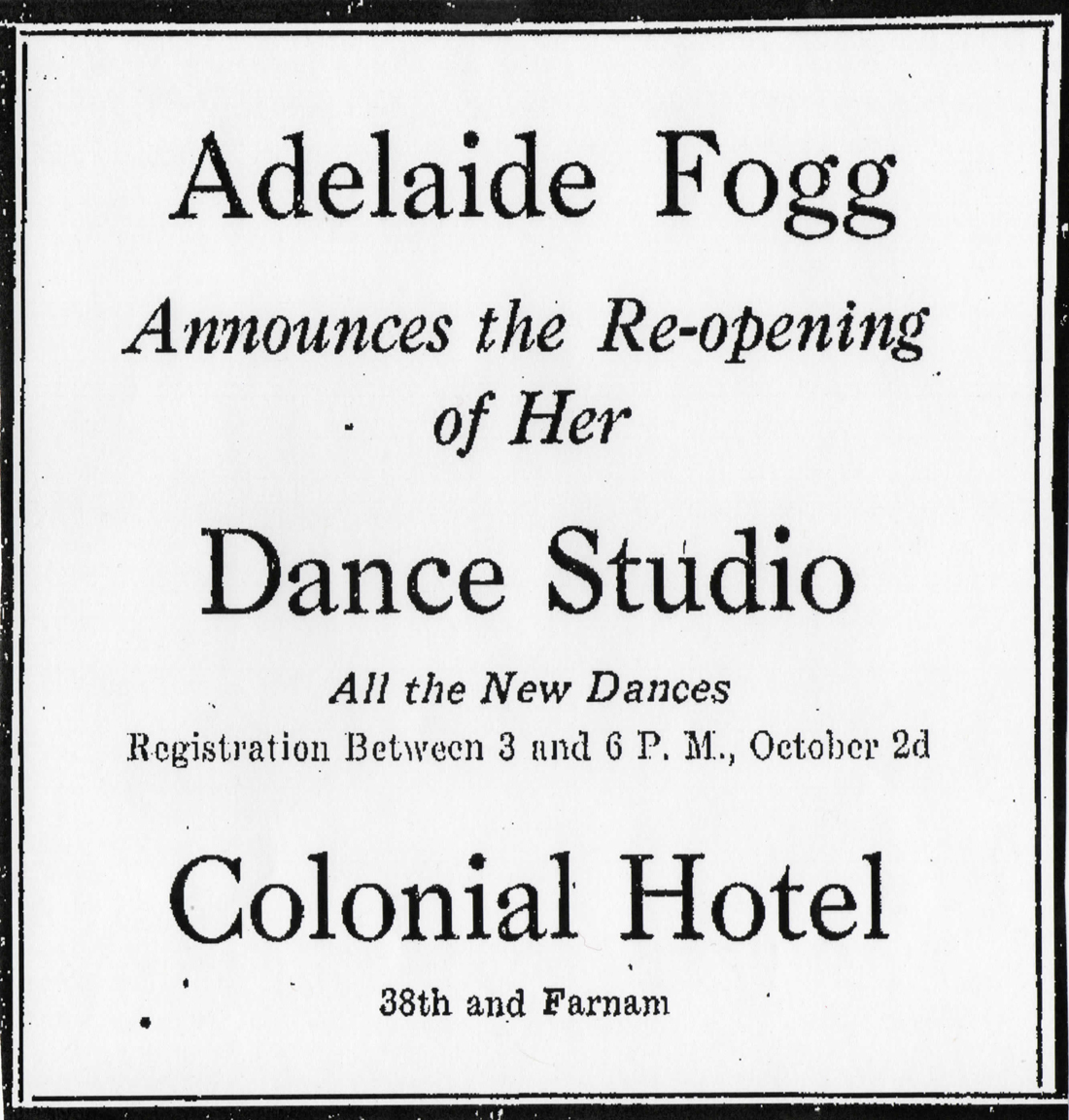
1926 Colonial Hotel ad. Miss Cassette approves of this font and classic advertisement.
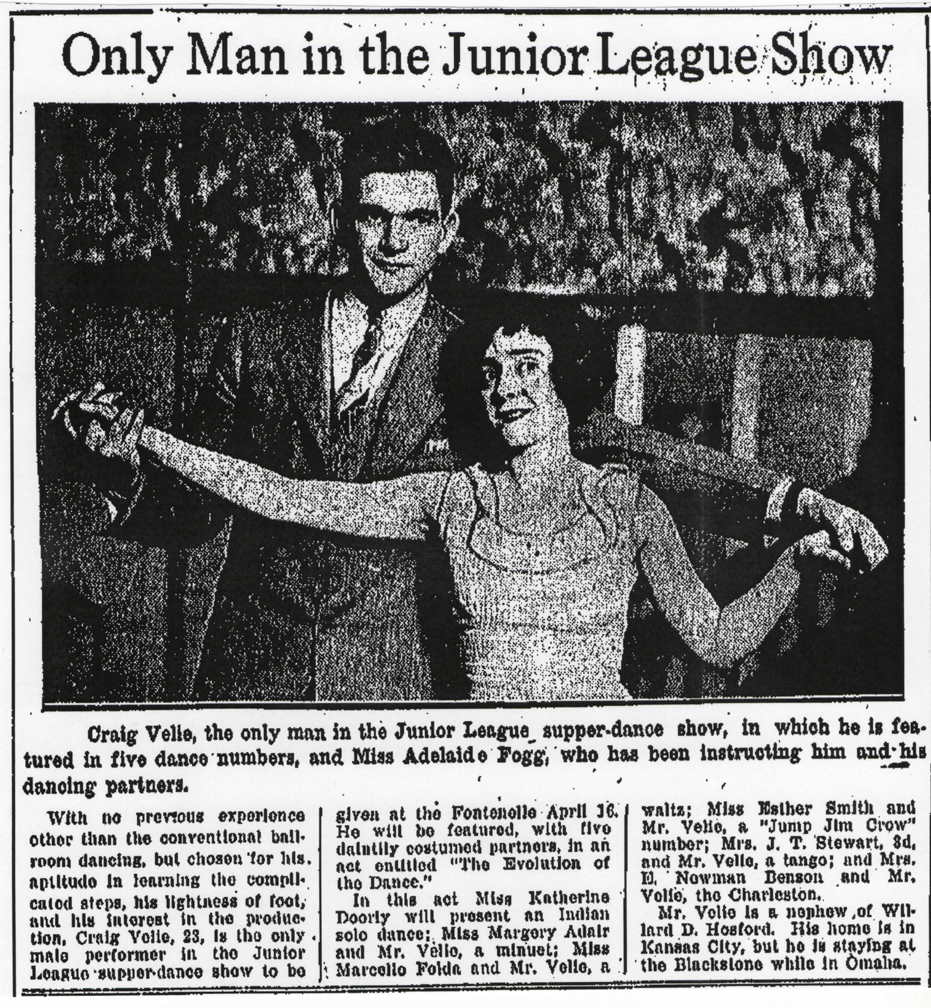
March 31, 1926 Only man in the Junior League Show chosen for his lightness of foot. Craig Velie is shown here with our girl, Adelaide Fogg.
I was so happy to find Miss “Addie” Fogg’s contributions affirmed in one of my favorite snooty Omaha books, West Farnam Story by B. F. Sylvester, as being The Preeminent Dance Instructor to the wealthy boys and girls of Omaha from the 1920s on. I also enjoyed the familiarity of Sylvester’s use of “Addie.” I think I will throw that around a bit. My other favorite Omaha (Life Styles of the Upper Crust) book, Born Rich: A Historical Book of Omaha by Margaret Patricia Killian, also recognized of our Adelaide Fogg. Ms. Killian fondly gave nod to the dance studios of Chambers, Adelaide Fogg, Pleasant Holyoke (that name!), Agnes Britton and Norma Mack, each offering their own specialties and techniques of ballet, classical, interpretive tap and stage routines which in turn, shaped Omaha arts culture and many generations of dancers to come.
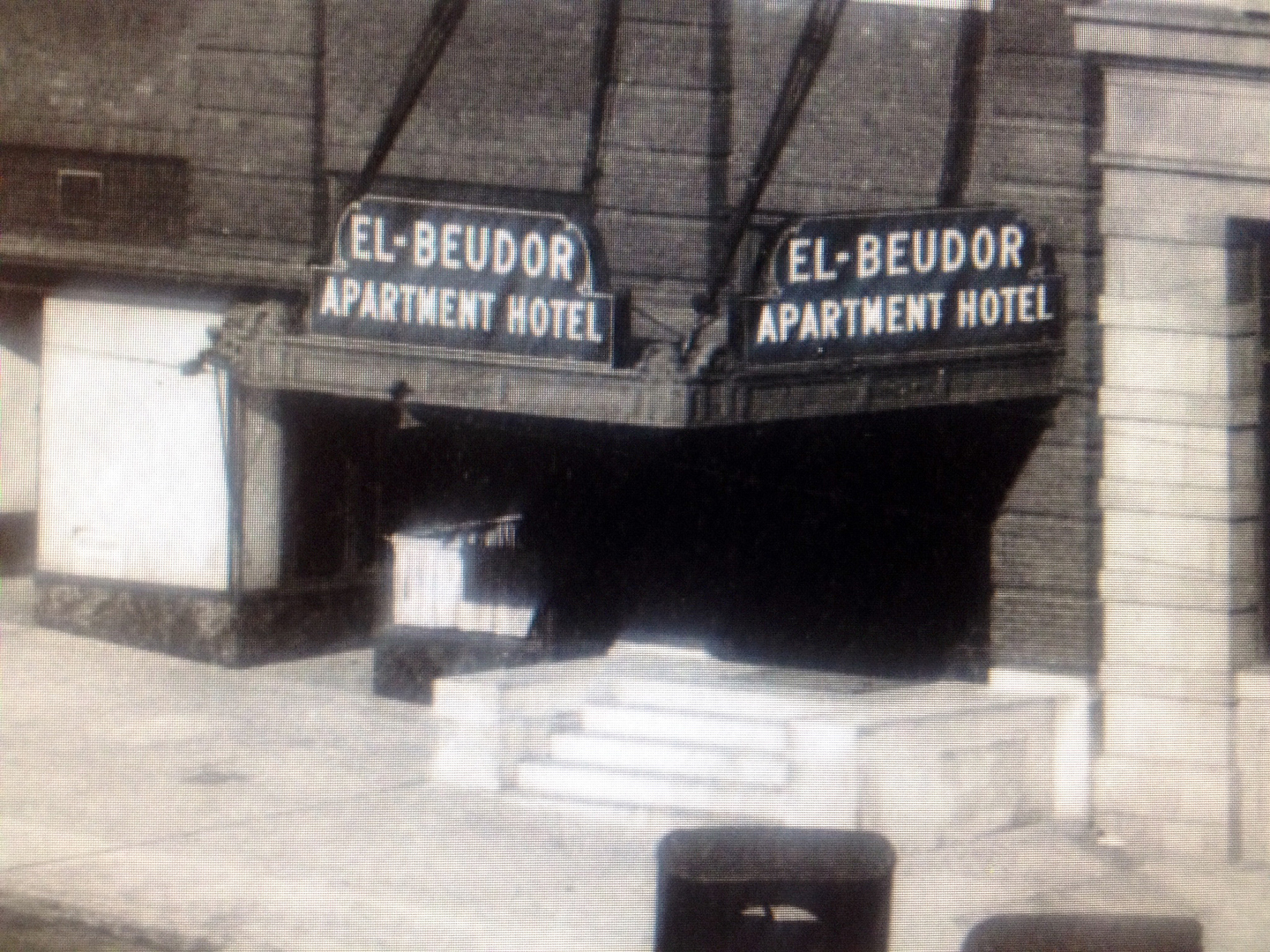 El Beudor detail.
El Beudor detail.
By May 11, 1926 the breadcrumbs led to “Mrs. Frank W. Fogg and her daughter Miss Adelaide Fogg have sold their home and moved to the El Beudor apartments.” El Beudor Apartments, twin buildings, were designed by local architect, James T. Allan in 1917. Allan was a World War I veteran, and a member of the American Institute of Architects. The El Beudor on 18th and Dodge Streets, erected in 1918 through 1919, like a number of hotel-apartment complexes of the time, were a mixture of newcomers looking to relocate to Omaha and more permanent residents. Years later Eugene Eppley purchased El Beudor in 1927 and changed the name to the Logan Hotel. For more on the Logan Hotel, check out http://www.nebraskahistory.org/histpres/nebraska/douglas/DO09-The-Logan.pdf
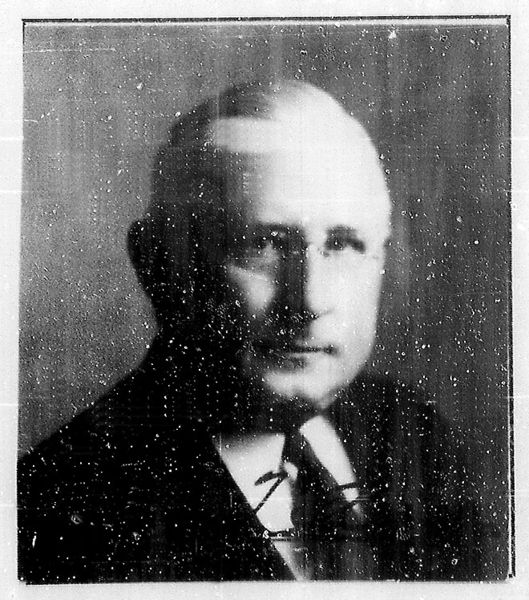
James T. Allan, architect.

El Beudor Apartment Hotel, later the Logan Hotel, on the northwest corner of 18th and Dodge Street. (Photo courtesy of the Bostwick-Frohardt/KM3TV Photography Collection at The Durham Museum Photo Archive).February 3, 1922. Sidenote: This is probably one of my all time favorite corners in Omaha. This forlorn corner and its buildings are in need of so much love but still feels absolutely big city to me. Just south of the Civic Auditorium (currently being torn down.) El Beudor was designed so well and is such a beauty from every angle, still. Will you go look at it? Okay…I think I just convinced myself to do a story on this.
Days after moving into El Beudor, mother and daughter announce their intentions on May 13, 1926. Adelaide Fogg and Mrs. Fogg will leave Saturday for 4 to 5 months on trip to NYC, Boston and Philadelphia in addition to a national dance convention.
By November of 1926, Miss Fogg returned, newly invigorated by her time away. “Adelaide Fogg, Omaha’s petite and charming dancer will present a dance number ‘Moonlight Fancies’ at the two dinner dances to be given by the Community Playhouse. Miss Fogg will wear a beautiful white ostrich feather ballet costume never before shown in Omaha.” Of course there was a photo of her in said costume. But I will give you this instead—
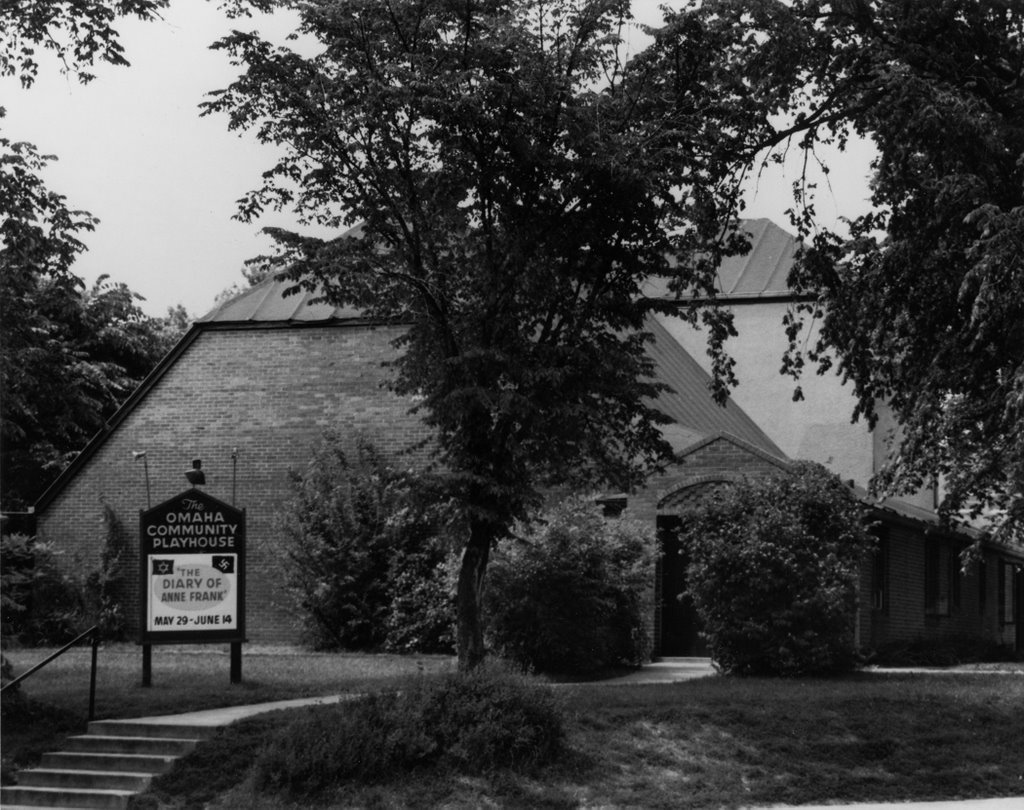
The Omaha Community Playhouse was located at 302-316 N. 40th St.
The December of 1926 Ever So Hometown newspaper headline announced “Miss Fogg left today for New York City to spend New Year’s Day in New York.” I love it. Have It Girls always done that? I guess so. Another favorite: in March 1927 “Cut that moon out,” commanded Adelaide Fogg while coaching a new dance she choreographed. Can we just admit that Miss Adelaide Fogg got good press? My gosh she must have known a lot of people or was an inspiration.
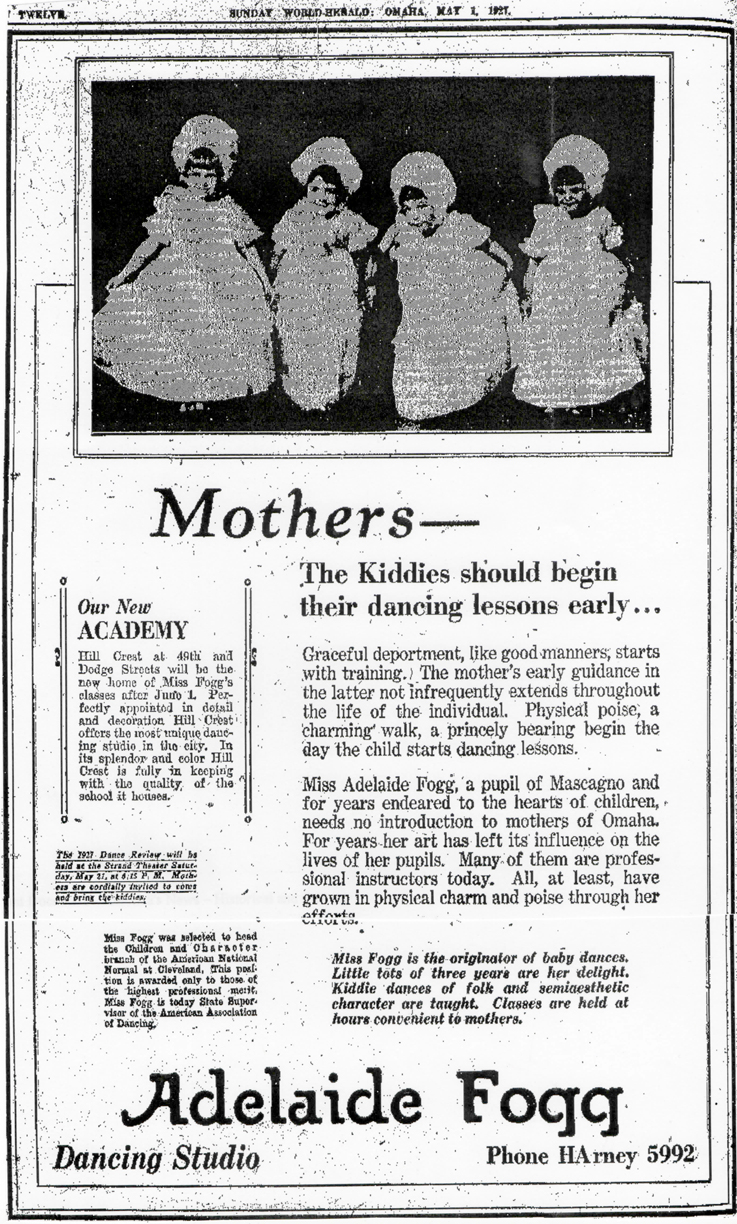
May 1, 1927 Mothers. My absolute favorite half page ad of the whole bunch and you know how I love old advertisements. First off: the toddlers in their costumes. Then get a load of this: “Miss Fogg is the originator of baby dances. Little tots of three years are her delight. Kiddie dances of folk and semi-aesthetic character are taught.” Baby Dances?!! Adore.
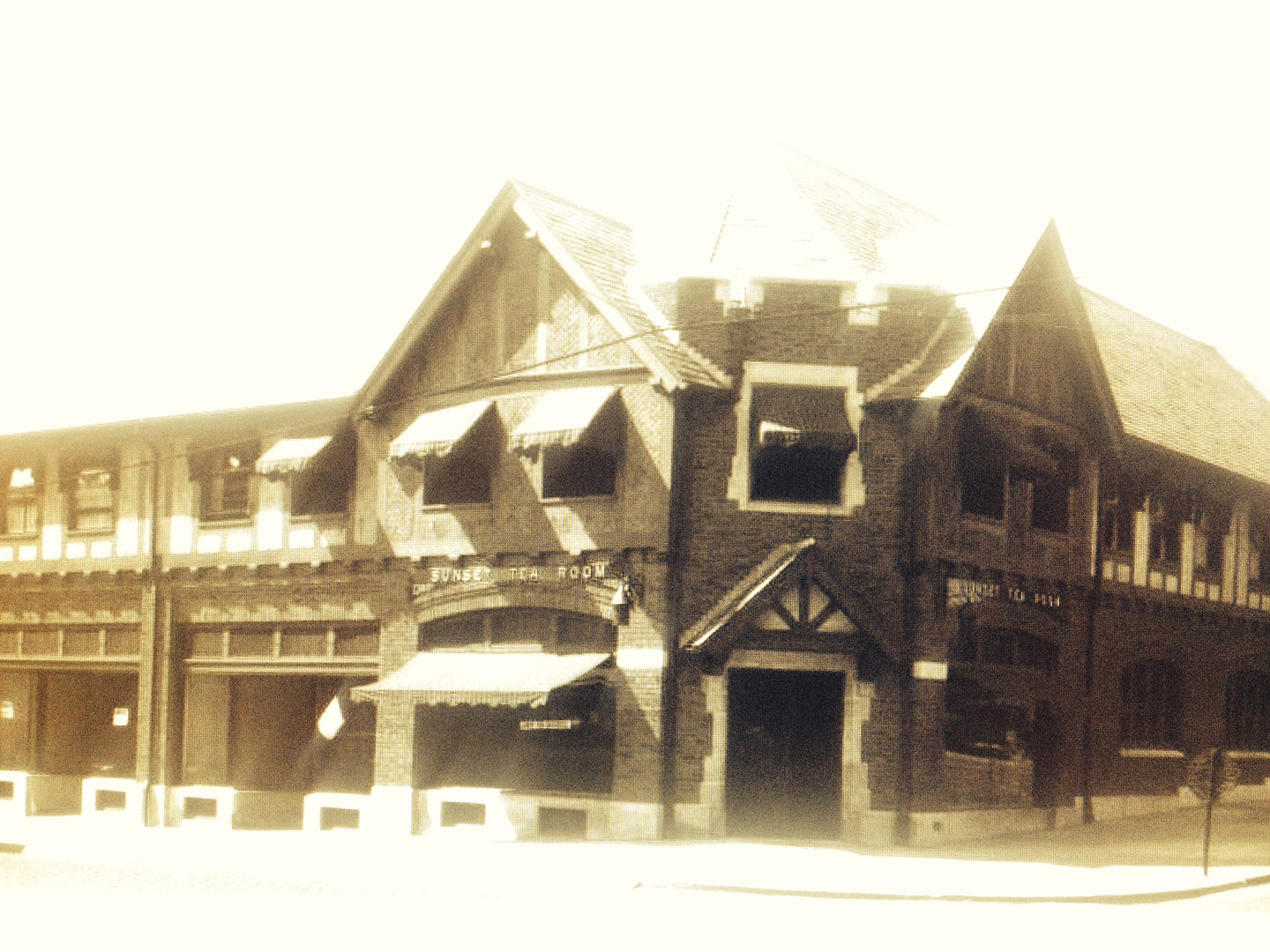
Noted–“Hill Crest at 49th and Dodge will be the new home of Miss Fogg’s classes after June 1. Perfectly appointed in detail and decoration Hill Crest offers the most unique dancing studio in the city. In its splendor and color Hill Crest is fully in keeping with the quality of the school it houses.” This amateur detective will admit to you that I didn’t know what the Hill Crest was. Not until I found this. Right here under all of our noses is the Hill Crest building. It has gone by a number of names through the decades. Designed by architect James T. Allan, here it is in 1927. Yes, the same architect of the El Beudor. You can see the exterior of the Sunset Tea Room. (Photo courtesy of the Bostwick-Frohardt/KM3TV Photography Collection at The Durham Museum Photo Archive.) June 27, 1927.

Interior of Miss Adelaide Fogg’s Dance School at Hill Crest. May 12, 1928. (Photo courtesy of the Bostwick-Frohardt/KM3TV Photography Collection at The Durham Museum Photo Archive) I am taken with their costumes and their little poses. If you can see it, Fred Astaire is framed in the background.
The Adelaide Fogg Residence

Google image map of 52nd and Dodge area.
And so here we have it, the very article that began my search. By April 3, 1927 the OWH released an article called, “New Home for Miss Adelaide Fogg.”
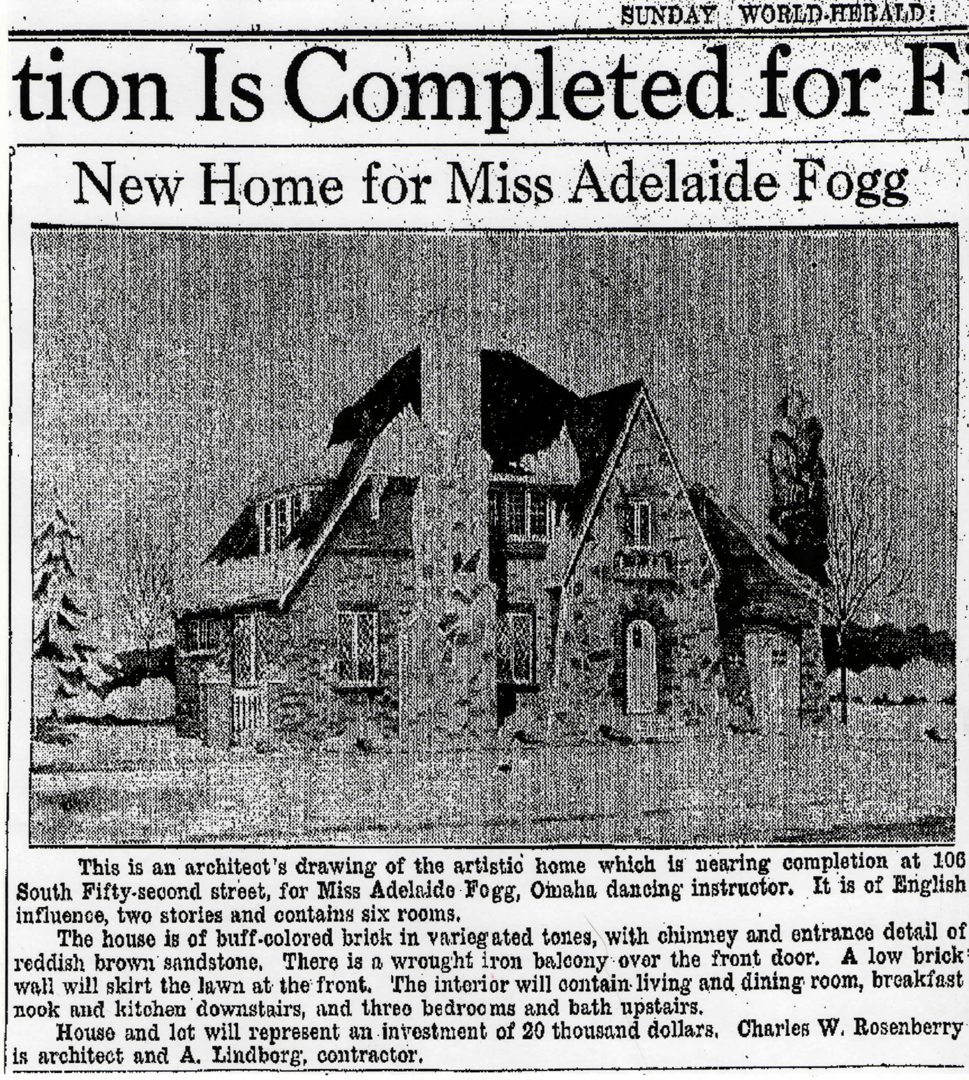
Charles W. Rosenberry was credited as architect. Rosenberry is best known for his numerous homes in Happy Hollow and the Country Club Neighborhoods. Check out http://www.e-nebraskahistory.org/index.php?title=Charles_W._Rosenberry,_Architect. Adelaide Fogg’s residence, of “English influence” was no doubt a collaboration between Fogg and Rosenberry. This storybook home, featuring an eclectic mix of both the Tudor and French Revival styles, really took off in the suburban 1920s. But what is quite unusual for this area is the façade of reddish brown sandstone used in conjunction with variegated bricks. This sandstone is repeated in a shallow fence along the property. This cunning, stone skirt fence has held my attention for decades! It was absolutely part of the original design. I had always wondered.

The little border as it looks today.

Floorplan from the Douglas County Assessor.
It would appear that the architect had intentions of using a leaded glass diamond pane window as seen in his World Herald rendering. These leaded-glass casements were popular with this smaller, affordable style of European home. But the windows must have been an expense that was cut out as they were not evident in the original photo taken of the home. The garage door of the original home featured a French farm feel complete with whimsical wrought iron strap hinges and vertical plank doors. The friendly arched front door was also vertical plank.
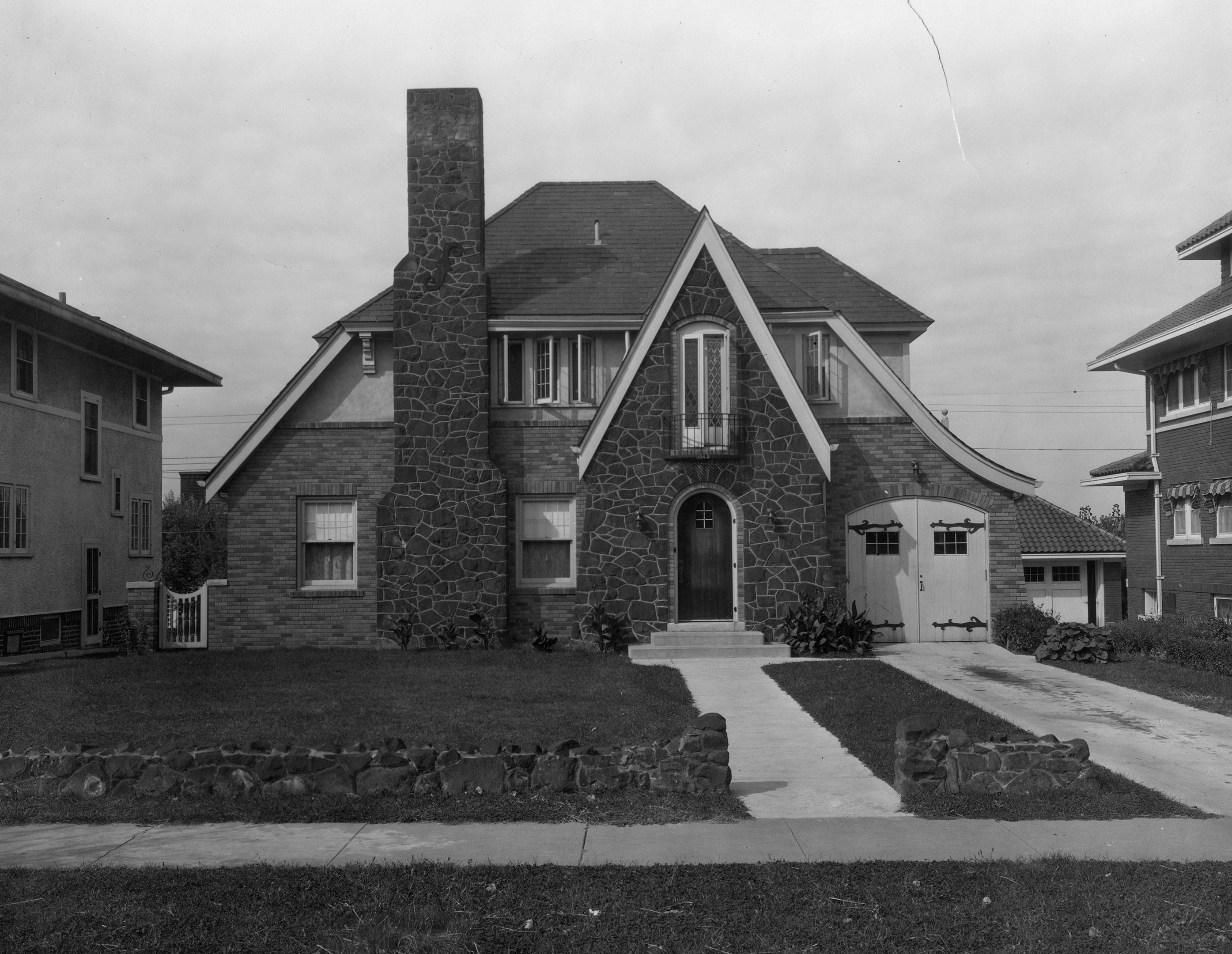
104 South 52nd Street as it appeared in 1928. (Photo courtesy of the Bostwick-Frohardt/KM3TV Photography Collection at The Durham Museum Photo Archive).

The current owners of 104 S. 52nd Street have done a wonderful job stewarding this property. The color scheme of trim, custom wooden blinds, the smart side gate and French country door is all very becoming (a complex order considering the roof tiles, sandstone and all of that multi-hued brick) and care to details is apparent. Those brackets, the steeply pitched sloping gable with the wonderful sweep of the garage roof! Take a spin by and you will see.
Strangely, the article from 1927 gave the address of Addie’s home to be as 106 S. 52nd Street. This gorgeous home, directly to the south, was built in 1916, a good ten years previous.

The true 106 South 52nd Street.
 One thing I have always wondered about this house, as I commonly wait at the Dodge Street lights, was the history of the fanciful “S” design on the chimney. This is an anchor plate, also called a wall washer. I had assumed that it had some sort of rod, which served to attach it to the chimney but I thought it might be purely decorative. Apparently these anchor plates are functional first, in that, they are used as a structural reinforcement for masonry. The decorative design of an “S” is also called a “S-iron”. These restraints were often made of cast iron, wrought iron or steel. I have seen other “S’s” in town (that sounds funny) as well as smaller stars on downtown structures.
One thing I have always wondered about this house, as I commonly wait at the Dodge Street lights, was the history of the fanciful “S” design on the chimney. This is an anchor plate, also called a wall washer. I had assumed that it had some sort of rod, which served to attach it to the chimney but I thought it might be purely decorative. Apparently these anchor plates are functional first, in that, they are used as a structural reinforcement for masonry. The decorative design of an “S” is also called a “S-iron”. These restraints were often made of cast iron, wrought iron or steel. I have seen other “S’s” in town (that sounds funny) as well as smaller stars on downtown structures.
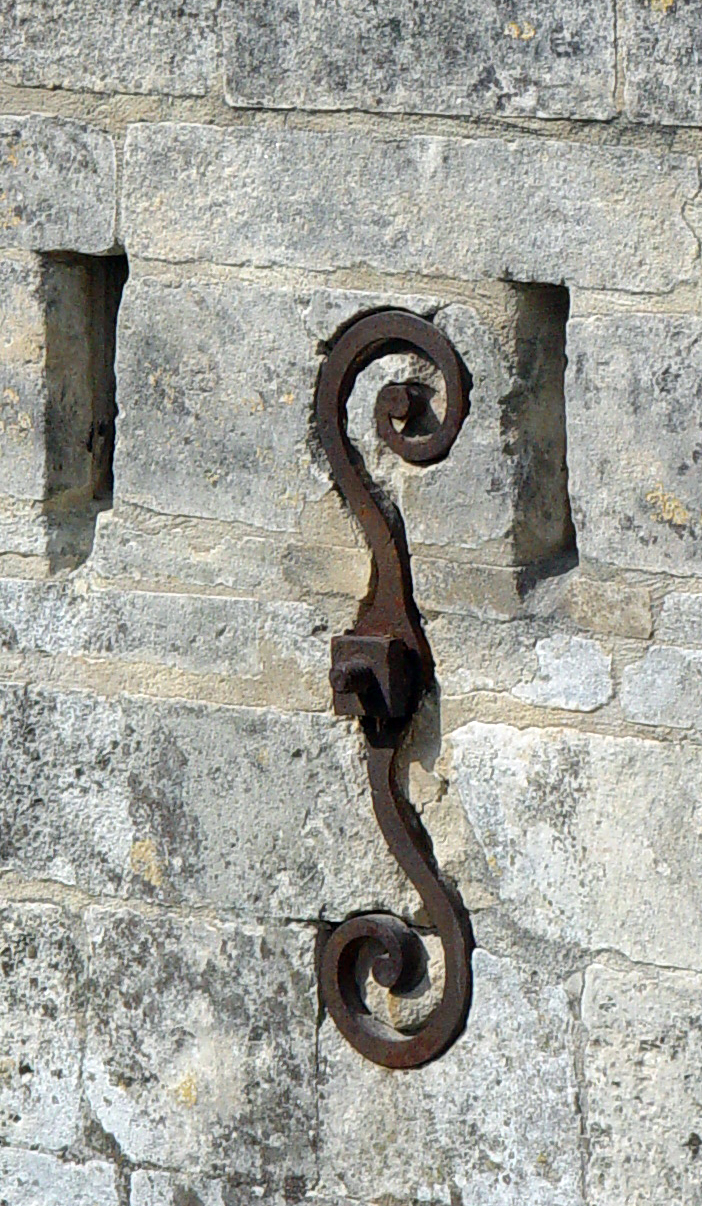
Yet another stylized anchor plate on the Church of St. Trophine, Arles, France.
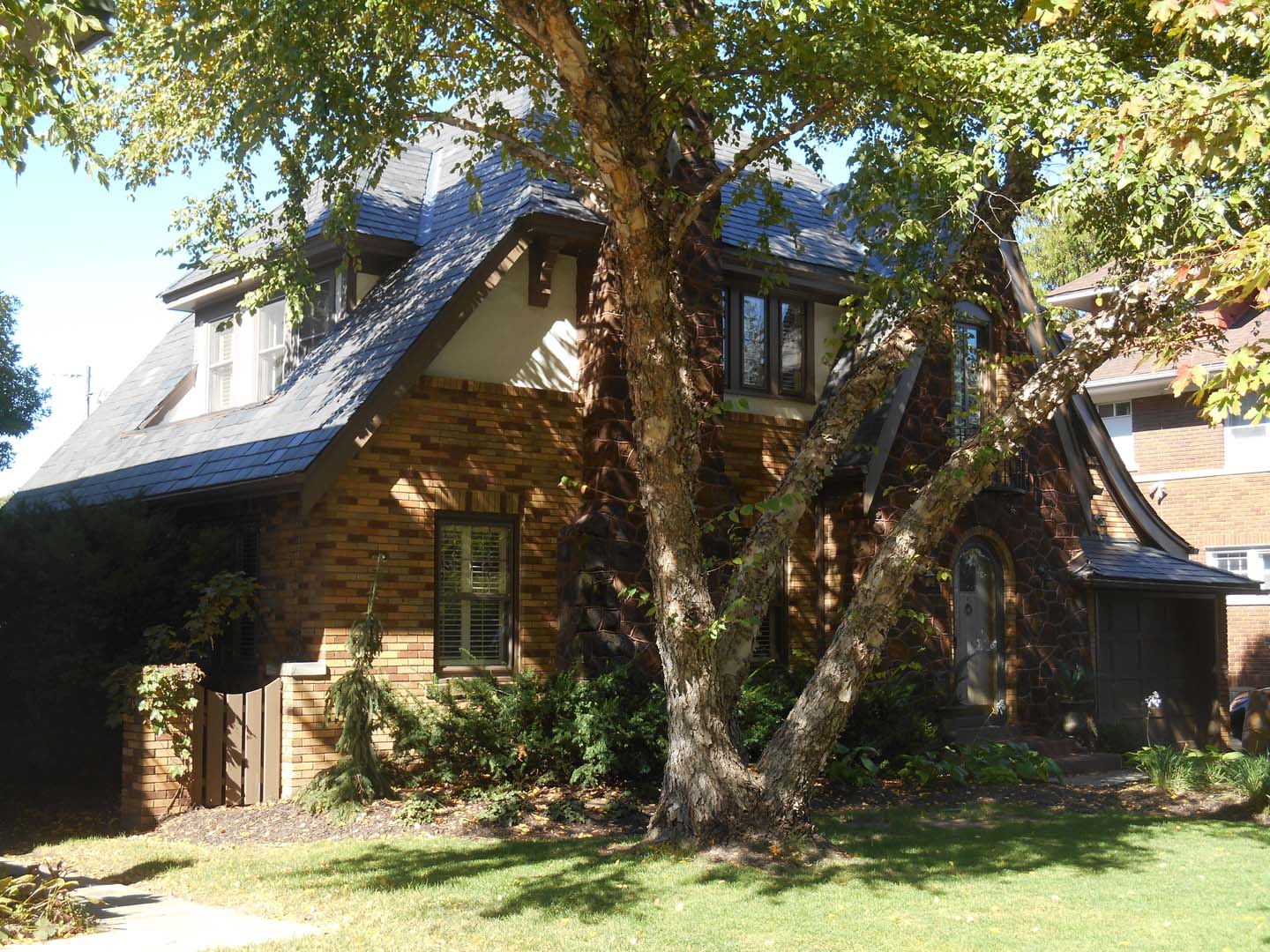
I was interested to find in the 1928 Omaha City Directory that Mrs. Mary Fogg was listed as owner of 104 S. 52nd Street. However the newspaper’s grand announcement was that this home was built for Adelaide. At the very least we can assume that Adelaide and her mother continued to live together after the El Beudor Apartments.
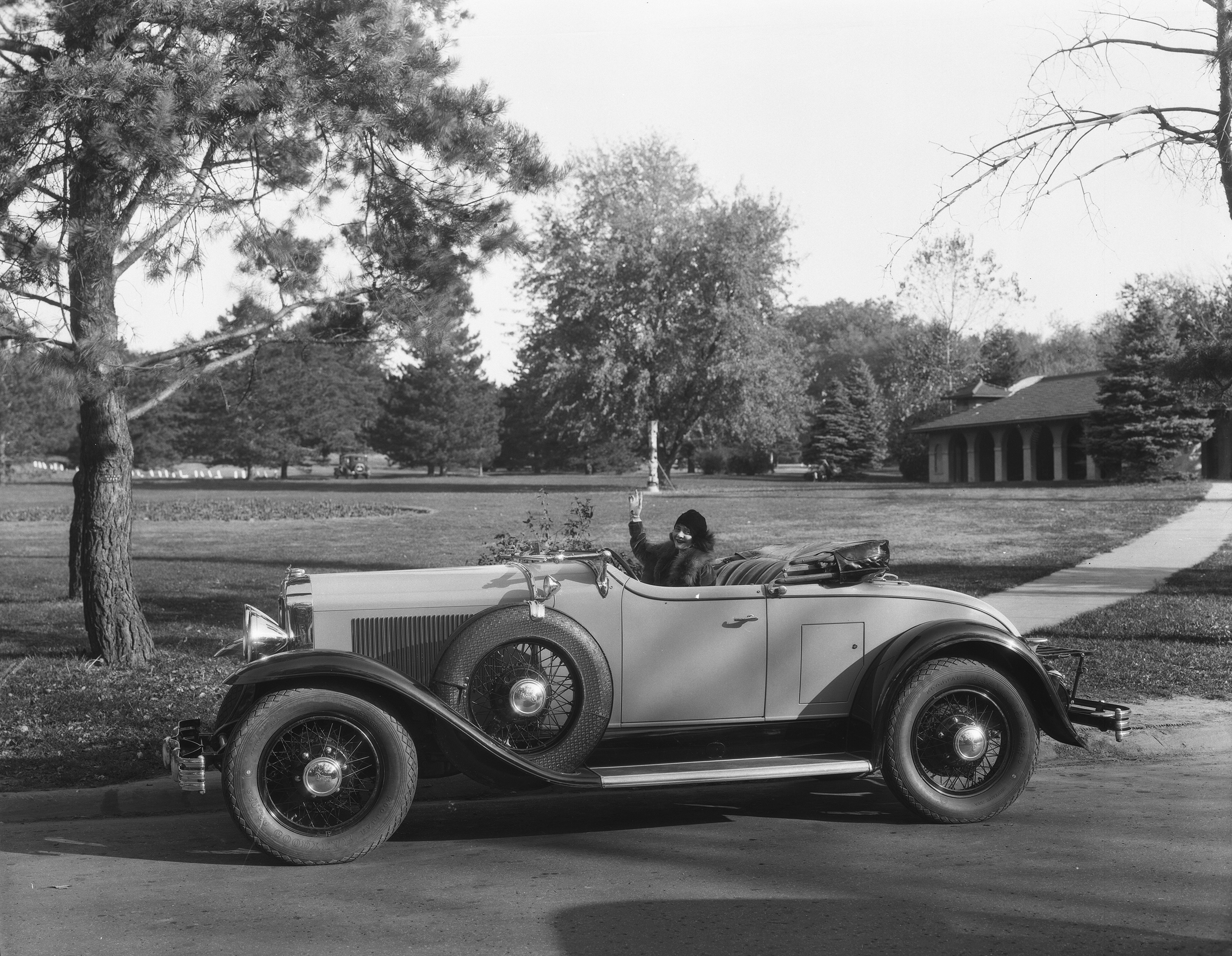
Here is Adelaide Fogg sitting in a Buick convertible parked at Elmwood Park. The Elmwood Pavilion, which looks much the same, is in the background. She is shown wearing a fur coat and is waving. I can only assume she is preparing for a parade. She hired Bostwick and Frohardt to take this photo of her. (Photo courtesy of the Bostwick-Frohardt/KM3TV Photography Collection at The Durham Museum Photo Archive). October 24, 1928.
The following years were big ones for Adelaide. In 1929 it was announced “A ballet of 40 girls directed by Miss Adelaide Fogg will be an added feature of the Ak-Sar-Ben Coronation Ball. Her title throughout 1929 had been elevated to “Foremost instructor in the Middlewest.”
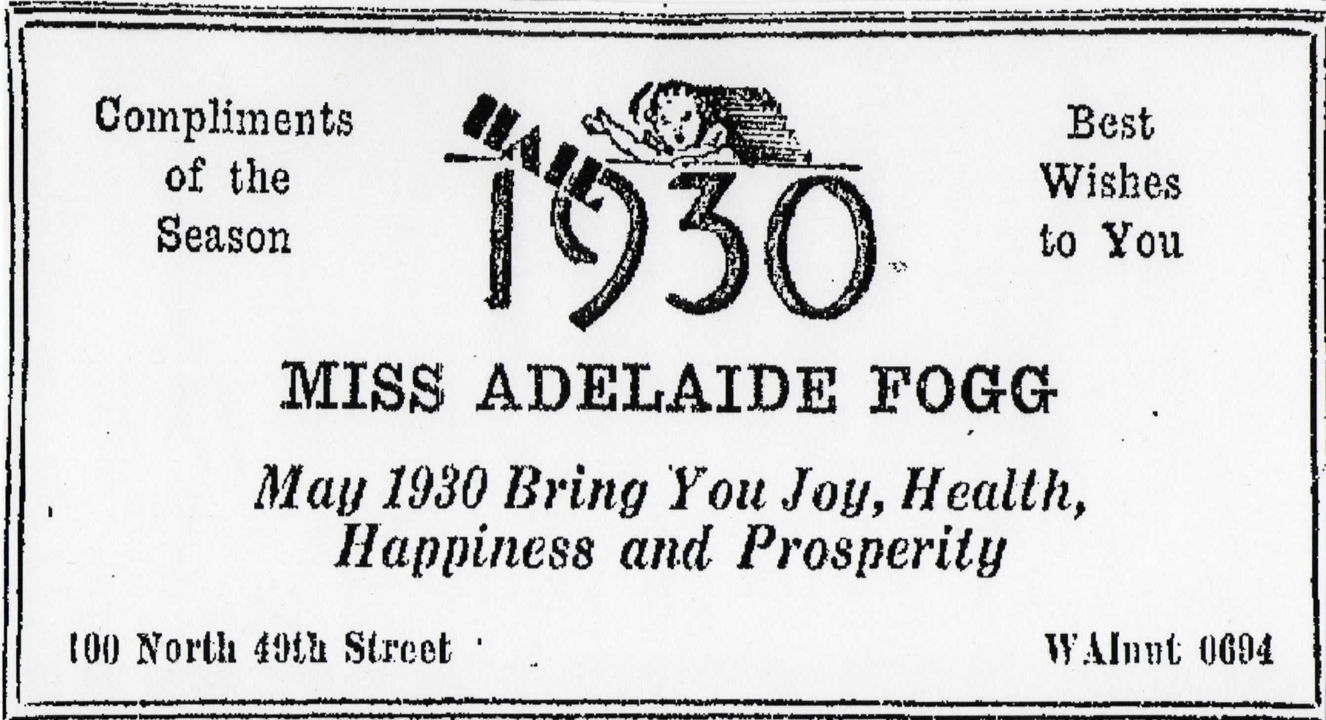
New Year’s of 1930 brought this charming,little announcement.
Stunning 1930s photo of Adelaide. By the way, is anyone else wondering if Miss Fogg had any love interests other than tennis and dancing? No, I am not in the least bit curious either….
Later Life
According to the Douglas County Register of Deeds, Mrs. Mary Fogg, Adelaide’s mother, died in August of 1939. She was taken off of the deed and replaced by Adelaide. The Omaha City Directory listed 104 South 52nd Street as owned by Adelaide Fogg, Dancing Teacher in 1939.

A sweet 1946 photo of four dancing pupils. The one on the far left looks as though she is going to start crying at any moment. This is a good photo because it shows the interior of what I think is her South 52nd Street home. It would appear that she taught dance in what would be the living room. I could be wrong about that. This might still be the Hill Crest. (Photo courtesy of the William Wentworth Photography Collection at The Durham Museum Photo Archive). May 2, 1946.
In a shocking turn of events, the Omaha World Herald announced on November 26, 1953—Adelaide Fogg and J. B. Caldwell Married Wednesday night. O M G. At age 56, “Miss Adelaide Fogg, long time Omaha dancing instructor and Jabin B. Caldwell (second coolest name ever?) were married Wednesday at 7 pm at All Saints Episcopal Church. In case you were wondering, like I was, Mrs. George Pangle (her sister, Ione) was there as was Jabin’s uncle. So her and Ione must have made up at some point. Let us just review: First time marriage at age 56. Ceremony on Wednesday night. Quite independent minded. If I didn’t already like her, I really began to admire her trailblazing spirit at this juncture of the investigation. “Following the ceremony a reception was held at the bride’s home where the couple will live after a weekend trip to Chicago.” I was able to find evidence tipping off that Jabin was a pilot and a businessman. Sadly Jabin died ten years later in 1963.
By 1961 I got my verification. 104 S 52nd Street was officially the Adelaide Caldwell residence as well as the Adelaide Fogg Dancing School. It was during this time period that she also became known for her hobby of taking in stray dogs and nursing them back to health at her 52nd Street home. Can you imagine this quaint little home filled with young children and dogs? This must have been such a lively place. I love to think of it.
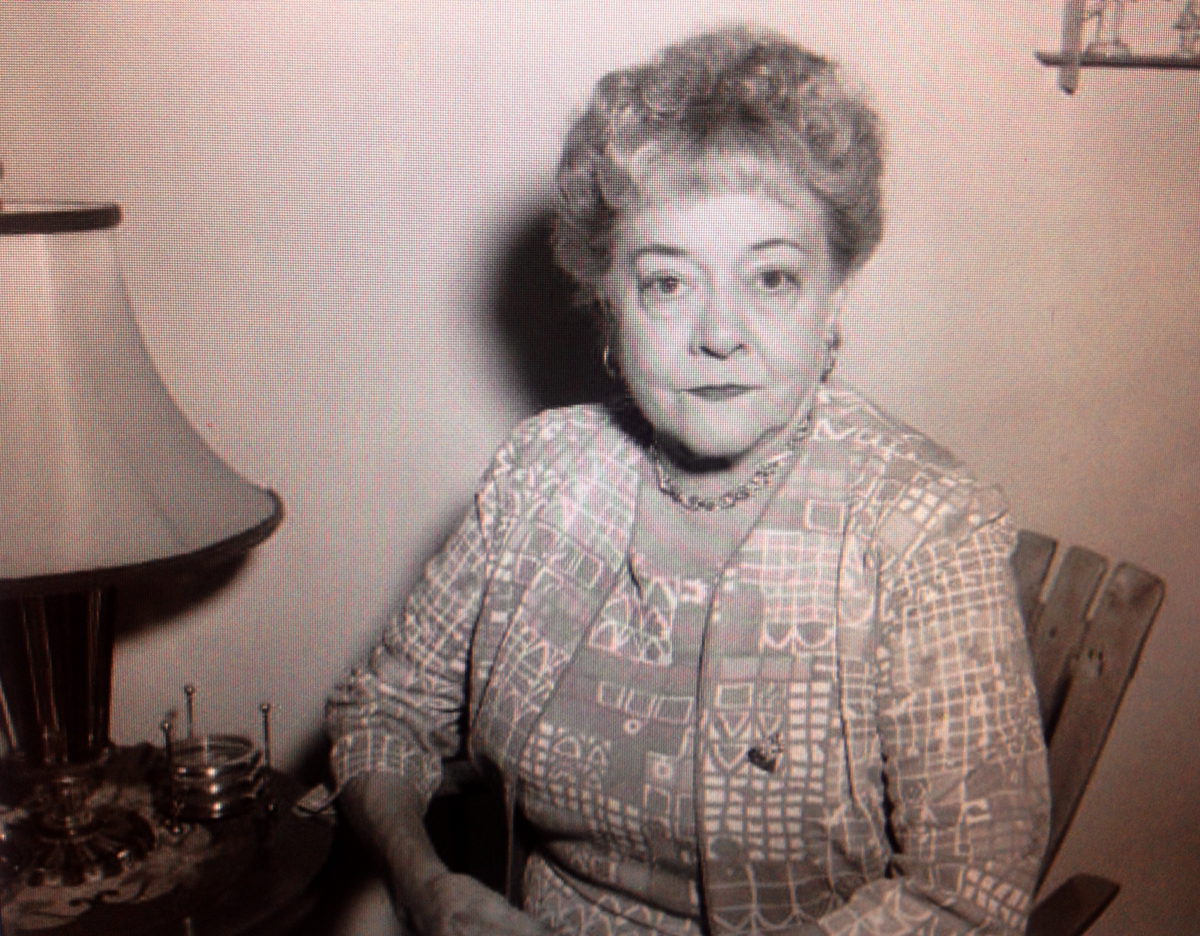 1969 portrait. And yes, I see that great little stacking of brass and glass coasters much like my great auntie had.
1969 portrait. And yes, I see that great little stacking of brass and glass coasters much like my great auntie had.
The Douglas County Deeds evidence points to Adelaide having sold the 104 S. 52nd Street house to Jackson T. Barnes in June of 1966. I stumbled across a fabulous news article of 1969, where by I learned many anecdotes that served to fill in the blanks of Adelaide’s life and her father’s commanding presence. Early in the article Adelaide admitted that she had never completely “gotten over an early day desire to dance professionally on stage.” She stated she gave up that ambition on appeal of her father, a promise she kept, even after his murder.
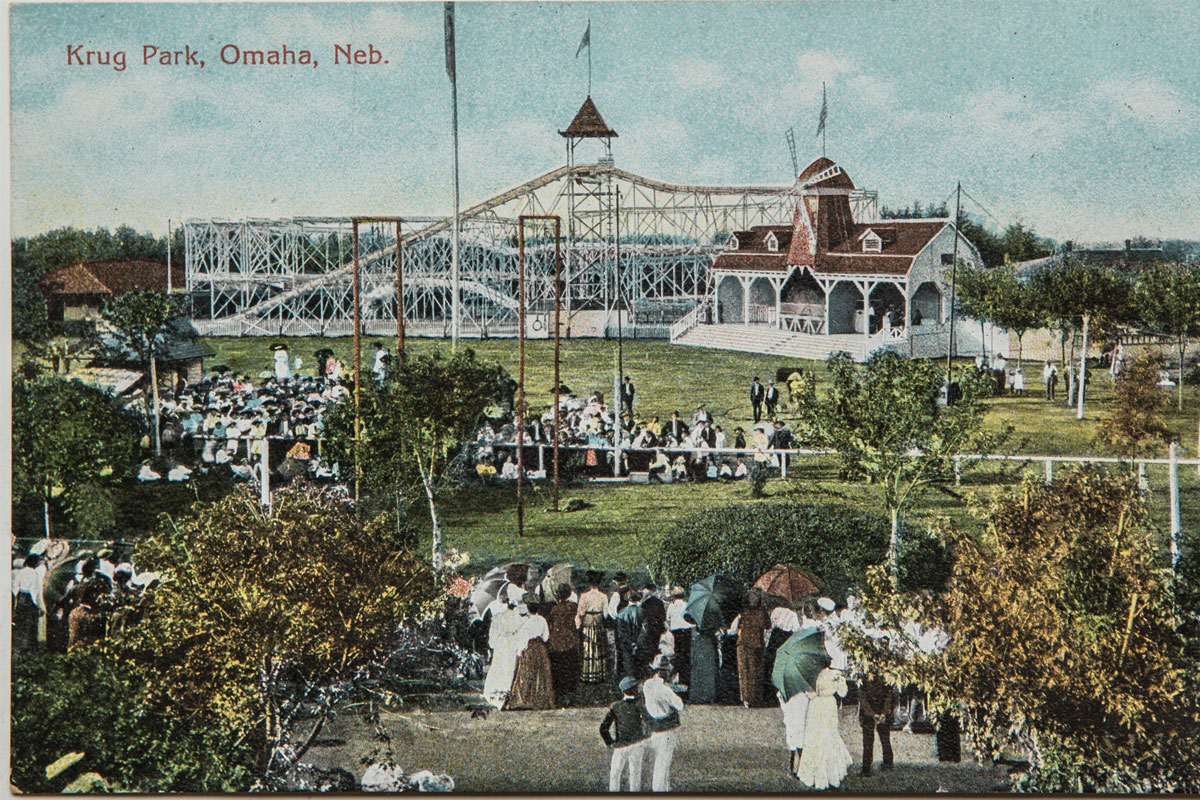
Krug Park. As Addie told it, at the age of three, her parents had taken her to concert at Krug Park in Benson. Adelaide was soon up on the platform, waltzing to the music. Her father became so outraged by her public display that he grabbed his daughter and insisted the family go home. I was also interested to find that the article made mention of her stature which had actually been hinted at all along. Pert, petite, tiny, a little mite. But finally in the 1969 article I learned that our Addie was “4 feet, 11 inches tall: size 3 1/2 ballet slippers.”
Adelaide also reflected back on her tennis years. “My shots weren’t so good, but I was fast.” In 1969 she was still quite active and continued to teach but on a limited scale. She had recently ended the season with 20 pupils, giving lessons in a penthouse room atop the Longo Apartment House. Her own apartment, it was noted, was on a lower floor.
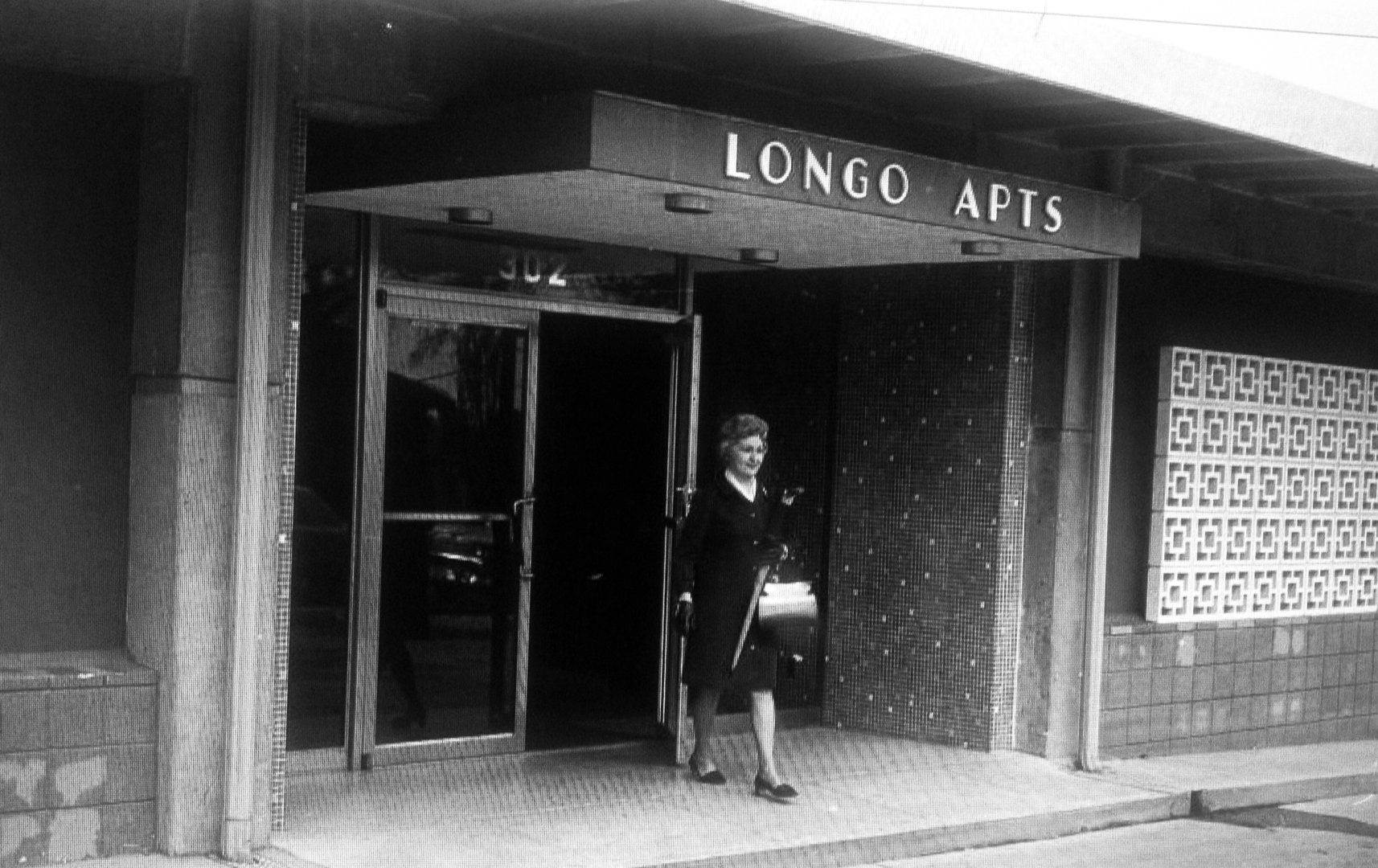
I am not entirely sure where the Longo Apartment house was but I have reason to believe it was in a cluster of newer apartment buildings by Joslyn Art Museum, around 22nd and Chicago. Here is Maxine Morrison walking out of the Longo Apartments in 1968. This apartment would have been very contemporary for the time, as it was erected in the mid 1960s.
**Addendum: thanks to the tip of reader Kevin Tierney, I was able to delve deeper into the Longo Apartments. The Longo Apartments were at 302 North 22nd Street. It is still standing, only now absorbed by Creighton University and called Heider Hall. This 84 unit apartment building, each individual unit with its own balcony, was originally opened in 1965 and was quite a modern spectacle. It was built by Dr. Joseph Longo and designed by architect Robert L. Shrum. It was called the #1 Apartment Building in America, and not just by the Longos.
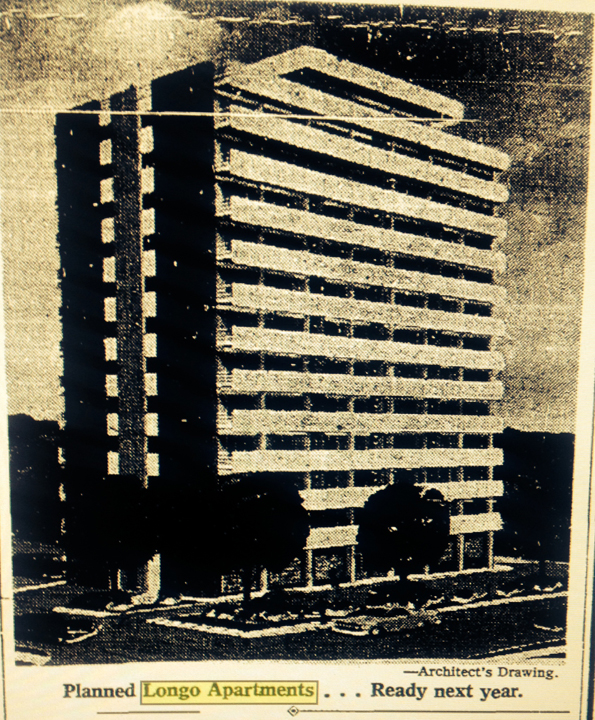
1964 architect’s drawing of the much anticipated Longo Apartments.
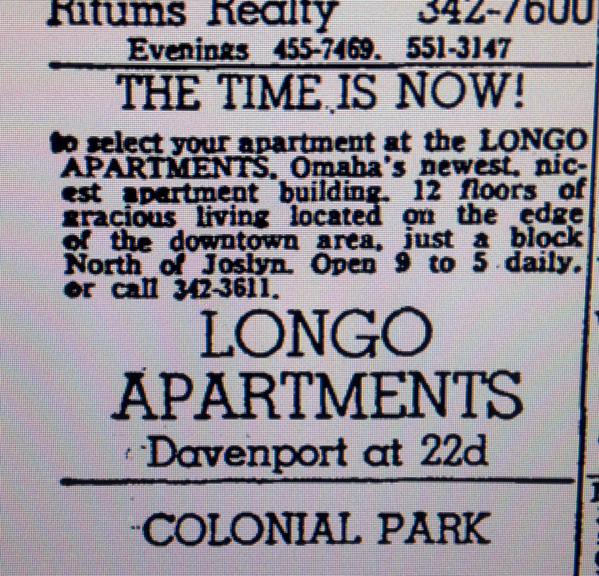
October of 1965.
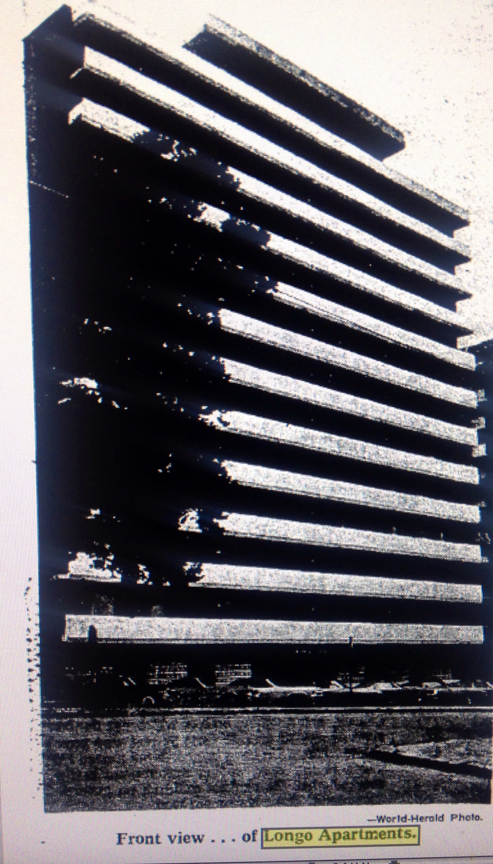
By October of 1972 a New Jersey-based partnership had purchased the Longo Apartments. HUD, through the federal housing administration had held the title of the apartment after a foreclosure action against Dr. Joseph Longo and his wife, Mary.
**Addendum: Thanks to reader and dance instructor extraordinaire, Robin Putnam, for informing me of the late, great Rudyard Norton, Omaha actor, who also lived in the Longo Apartments and was acquainted with Miss Adelaide. Apparently his scrap book of memoirs is housed at the W. Dale Clark Library. I must look into this immediately. She believed that Rudyard lived at the Longo in the last five years of his life.

Adelaide was quoted in 1969 as saying, “When I can’t demonstrate the steps anymore, I’ll quit. But until then, I’ll go on. This is my life. I’d rather drop dead on the floor than to stop.”
Miss Adelaide Fogg died in 1981 at the age of 84. She died at the Lutheran Home where she had lived for three years. I could not resolve why she had moved there. She was buried at Forest Lawn Cemetery. From her early life as a dancer turned tennis champion turned dancer turned teacher to the society girls, Adelaide was quite different from her peers. In fact I do not know that she actually had peers. So many white women from this time period and of that social standing were in the newspapers for playing cards at tea parties, fundraising and hostessing events. Adelaide was different. That is apparent. She was traveling and always pushing herself forward in her active pursuits. She was quite remarkable in her determination to better herself. Adelaide taught many thousands of Omahans, young and mature during her 50 year career. Although she continued teaching other styles of dance, according to her obituary Adelaide stopped teaching ballroom dancing in the late 1960s “because she disliked rock music.” And I can hear her now. After all of this following and digging and getting nearer to her spirit, I can hear what she must have sounded like to her students. A very strong voice I have never heard before, quoted in the World Herald as saying, “You don’t have to have lessons to do what they do. I don’t call it dancing. They act as though somebody stuck pins in them.” RIP Miss Adelaide Fogg, you were just my kind of girl.
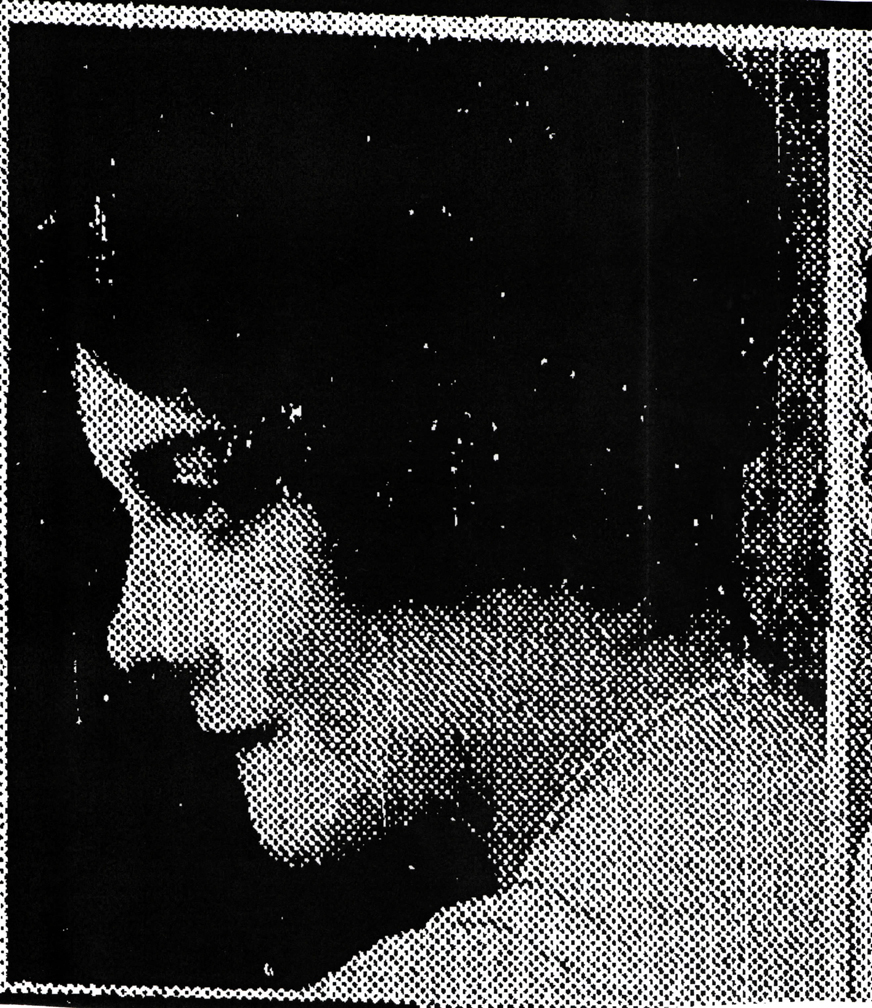
I welcome your feedback and comments on the great Miss Adelaide Fogg, any of her fabulous homes and studios. To enable comments, please click on the header title. If you would like to correspond with me privately, please do so at myomahaobsession@yahoo.com. But I assure you, everyone would love to read what you have to say and it makes the conversation more fun. You can keep up with my latest investigations without even leaving your inbox, by “following” myomahaobsession. You will get sent email updates every time I have written a new story. Thank you, Omaha friends.
© Miss Cassette and myomahaobsession, 2016. Unauthorized use and/or duplication of this material without express and written permission from this site’s author and/or owner is strictly prohibited. Excerpts and links may be used, provided that full and clear credit is given to Miss Cassette and myomahaobsession with appropriate and specific direction to the original content.


This is just a guess but I think the Longo
Apartments are now Heider Hall, a Creighton residence hall. That photo stirs a memory forms. Before it’s remodel it was a great mid-century modern building with purple tiles along the front and sides. Add the horizontal white lines of the balconies and it was pretty striking. I loved the glamorous look of that building and imagined Lisa Douglas spinning and admiring her “Penthouse View”. It’s all earth tones now. Sigh
Oooh good one! I will investigate tonight on GIS. I remember that grouping of apartments as a child looking on from the interstate. Soo modern! I thought it might be cool to be an adult. I always wanted to catch someone out on their balcony. Thanks for the tip!
Thank you for such a wonderful article. Haven’t been in Omaha for years, but born and raised there and my two younger sisters and I took ballet lessons from Miss Fogg in the early 60’s in her lovely home. The living room just left of the front door was her mirrored and barred studio, the kitchen just behind it on the left side of the home. Upon arriving for your lesson, we would go directly upstairs just in front of the door, to a little room at the top and left of the stairs. It has a quaint balcony type window and the room was so feminine and lovely with soft lighting. As a kid, I was impressed by the fact we could be up there alone, unsupervised in the private living quarters!
Miss Fogg was strict but a good teacher. She was tiny and used a cane to push and prod our feet into proper position! We were required to wear very dated pink bloomers, rather than the skin tight body leotards and tights of most ballet schools. I think she might have been in pain, as I do not remember her smiling very much, and she was strict with a very high shrill voice, but she really cared about us and wanted us to be the best. I am certain I learned better posture and poise, but we were glad when the lessons were over! From my perspective as a child, it was not pleasant, but I do know she was caring and a professional!
Thank you again for such great writing! I also remember Bishops with getting a footed ballon saying ‘Welcome to Bishops, Little Friends!’ Your writing is wonderful, so many things I had forgotten! Thank you for the fantastic research, photos and writing! 🙂
Marilyn, thank you so much for writing. What a visual! I can absolutely envision her home from your lovely description in conjunction w the Durham photo. I also appreciate your perspective on her personality and antics. What a character! Thank you for your nice words. You’ve filled my heart w joy!
Thank you for your kind words… I see there are two posts from me, I didn’t realize the first one posted, so feel free to delete that first earlier one if you wish. They essentially say about the same thing, but my wording was a bit better – kinder – in the second one!
Yep, Miss Fogg was a character, did you know her? I sure hope you are paid for all your hard work and writing skills! Your writing is absolutely delightful! Thanks again! 🙂
Sent from my iPad
Hello again. I will go in and delete it. No worries. No, I never knew her nor had I ever heard of her before the news article. I am not paid–just my idea of fun. Have a great weekend and thanks again.
Addie Fogg was quite a woman and a most determined and accomplished ballerina. My sister and I were both students. Addie had a piano player on the keys providing her students with music at every lesson. One of the dogs she saved, a black lab, was spied outside the old Brandeis Department Store. Addie asked her taxi to pull over so she could put the dog in the cab. She named the dog “Brandeis”
Wow! What an interesting and enjoyable piece to read and the photos added so much. I appreciate all the research you put into it. I only lived in Omaha about 3 years (69-71), two of them at the Longo during my twenties. I ran across you totally by accident, just sitting here and googled Longo Apartments since I had recently seen the building in an aerial shot from the George Clooney movie “Up in the Air” (about 15-20 minutes in). Probably something to do with your Longo Apartments tag, right.
Anyway, it sounds like I was there at the same time Addie lived there and taught classes, probably in what we called the party room, on the roof. I wish I had met Addie; for all I know we may have passed in the lobby or shared an elevator. Another notable resident was former Nebraska Governor Frank Morrison; you have a photo of his wife Maxine coming out the front entrance. My roommate and I ended up with the apartment the Morrisons had lived in, one of only 4 two bedroom units in the building. It was on the 11th floor and we enjoyed great views of downtown and sunrises over Council Bluffs. The Longo was managed by P J Morgan’s Realty and Property Management Co.
Thank you so much!
Oh how great! Thank you for writing in. I really want to do a story on the Longo and that interesting little strip of apartments there. I can imagine that the four bedroom on the 11th floor was pretty spectacular.
To clarify, our apartment was a two-bedroom, the Longo building only had 4 two-bedroom units. They were indeed spectacular and quite large at 1,100 square feet plus a balcony running the entire 50 foot length of the apartment.
I think P J Morgan could be a valuable source if you do anything more on the Longo and surrounding area. I recall hearing the building next door to the Longo (north) was a retired teachers home but can’t verify.
Oh, I see now. You had written one of only four two bedrooms. Sorry for the confusion. Yes, I had found the PJ Morgan connection in the short research I did when Dr Longo had to let go of the building. It will be fun to dig more when I have gotten through these stories before me. Thank you for your tips.
Thank you so very much for all your biographical research on my great-aunt Addie. I’ve sent the piece to all of the relatives so they can enjoy it as much as I.
I’m a grandson of Ione Fogg, sister of Addie. Ione and GW Pangle, Jr. had two children, my father GW Pangle III, known as Bill distancing himself from his full name of George Washington, and Adele. The split in the family over my grandmothers inheritance did mend somewhat over time with Addie becoming like a second mother to both by father and aunt.
Adele herself was an accomplished ballerina, who trained with Addie for over twenty years. My father also studied with her taking tap, and was a star half back for Omaha Central earning the moniker of ‘Dancing Billy Pangle’, crediting dance for helping him elude tacklers.
I’d be fibbing if I told you all was well between the sisters with my grandmother always resenting her disinheritance and the obvious fact that Addie was her dad’s favorite. Unfortunately life did not treat my grandfather and grandmother well, living in the back of their small musky store, National Sound Equipment, 1212 Farnam St., what is now part of the Gene Leahy mall lagoon. Christmas was the only time all the family got together with Addie and Jib hosting.
Addie, as others have mentioned, was a good, yet strict instructor. I took tap from her, like my father, but never really enjoyed it thinking it was taking up valuable time from playing with my friends. Going to Aunt Addie’s house for Christmas wasn’t the most fun thing for a boy to do other than play with the dogs Brandy and Skippy, who I loved. I understood not having children herself, how hard it must have been for her to relate to a child who just wanted to play and not dance and always felt sorry for her not having any of her own. One time I went down to play in the coal room in the basement of the house and was covered in coal dust, coming into the living room I can still see Addie clutching at her prim and proper chest. LOL–I just figured out why she didn’t have any children!
Jib was one cool guy. Always dressed to the nines in a suit, tie, and watch fob, yet friendly and personable. I think he must have had the most extensive collection of ties in all of Omaha. Any time I’d bring a tie down from his closet he’d laugh and take the time to tie it on me showing how to various knots. I remember the time he ‘shaved me’ using his straight razor and strap which made a sound like no other being sharpened. I was really upset at his passing from a heart attack in his sleep.
Addie was bed ridden for some years due to a fall breaking her hip, and was stoic in accepting her condition up to the end. Addie was always proud of the Fogg name, tracing her genealogy back to the Mayflower and the Fogg art museum at Harvard. I’m sure if she were alive today her favorite TV show would certainly have been Downton Abbey.
THIS is the most amazing thing I will read all day! Thank you so much for these details and sharing your family story with us. Please, if you are willing, send a photo of your grandmother or any family members. Cell phone photos are fine. We would all love it. My email is myomahaobsession@yahoo.com. If not, thanks for writing in and giving this private account. I really appreciate it.
I went back to read the comments on the blog…they are wonderful! I sent some pictures I have in my scrapbooks of items related to Miss Fogg. As one commentator mentioned, Adelaide had a niece, Adele, who is pictured here. She was the dancing partner to my dance teacher, Mildred Collins. The picture of Miss Fogg that has her birth and death date below was a copy of the picture of her that hung in our dance studio, right by the record player where Mrs C could see it throughout class. Much of her description of her own teacher was much of how we saw Mrs C as well…very petite (about 5’2”) who demanded discipline but was also ver kind and like another Grandma. We all loved her and wanted to do well for her and I think that is how Adelaide was viewed as well. I went on to teach with Mrs Collins myself and hoped I had followed in the footsteps of those before me. I also am only around 5 foot but felt dance was about to discipline but loved my students like they were my own kids or younger sisters in some cases.
Mrs C often told us stories about Miss Fogg and her dancing cane and how she would use it to get your feet into the right position or get you to straighten your knees. She also would tell us about how tiny she was mentioning her height and little ballet slippers but how she still commanded discipline but that she was also kind and loving which made us laugh because Mrs Collins was the same. We drove past some of the old places once, when we were out looking at items for an upcoming recital and drove by some of the old places Miss Fogg taught at or dances herself and her old home off of dodge. Another characteristic of the three of us that I was reminded of by your story was our love for dogs. Mrs Collins often spoke of her chow she had as a child. Normally a rowdy breed hers was very calm and loving and actually would wait for the mail man to come by each day who always had a treat for him. I remember I myself was late for class one evening after I had began to drive myself to lessons. Usually that was frowned upon but after she learned it was because I had seen a stray dog running around and I just had to stop and help him find his home she understood. We often joked about getting a little tux for my toy poodle to wear at the recitals. Your story brought back many fond memories for me. Thank you!
When I was four and my sister was eight (1952), my mother would take us on the bus once a week so my sister could have her dance lesson with Miss Fogg. This ticked me off mightily, inasmuch as it meant I had to miss Howdy Doody, which used to be on every weekday afternoon. I would sit there with Mom, watching the girls hop to it; I remember being afraid of Miss Fogg, since she appeared to be gruff and non-nonsense. Once I got up the nerve to call her Miss Foghorn – typical humor for a four year old – and somehow I managed to survive. Her house/studio was particularly enchanting at Christmas, beautifully decorated – my first exposure to the magic of tinsel.
Years later (it must have been in the 70s), my mother ran into Miss Fogg somewhere and she asked about me. I was astonished that she remembered me, as I had never been a pupil – only a pesky little sister. My mother told her that I had moved to New York City in 1968 and was doing professional theatre, mostly musicals. Then Mom said Miss Fogg got a wistful look on her face and said that was what she always wanted to do, but never did because of her father’s wishes. So sad – it made me grateful to have had supportive parents; once you’re a theatre/music/dance person, you can never not be that; it’s as immutable as eye color. Needless to say, I never forgot Miss Fogg, and I wish I could have interacted with her as an adult.
Dear William I am Carol Dunlop ,living in kenya, and had an aunt Adelaide fogg. Who lived 1912-1993 and was a well known artist in new your and California. Amazing that 2 such spirited women, both influential in the arts at the same time when most women stayed at home, carried the same name. My grandfather Harold Hartford Fogg came from England and we have the lineage report. Do you think there could be some familial connection? Interesting hope to hear from you best carol
I’m here all these years later after seeing Aledaide’s home listed for sale and they included a clipping of the article about her home’s construction in the listing. The first home I bought (as a single 29-year-old girl) was on 52nd & Western, and I loved researching the history of my little home, so reading about Adelaide’s spectacular life was fascinating. In the listing, you can see a photo at almost the exact angle of the photo you have of the four little girls — confirming that the photo was indeed taken in her living room. I’m happy to see that the home has been respectfully updated but retains so much of the original charm. https://www.realtor.com/realestateandhomes-detail/104-S-52nd-St_Omaha_NE_68132_M83411-95682